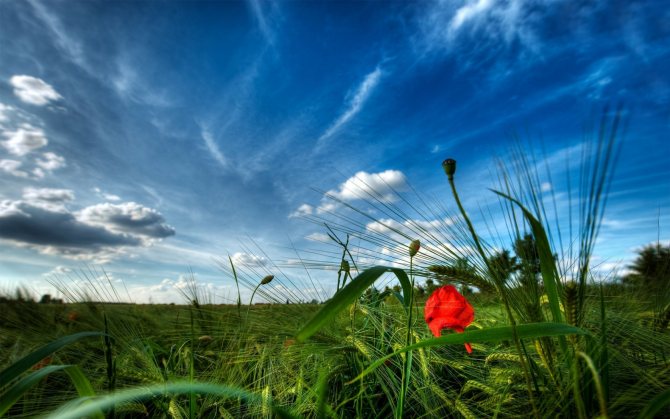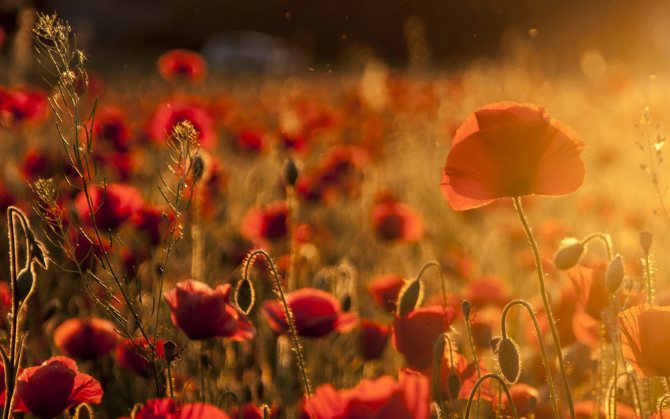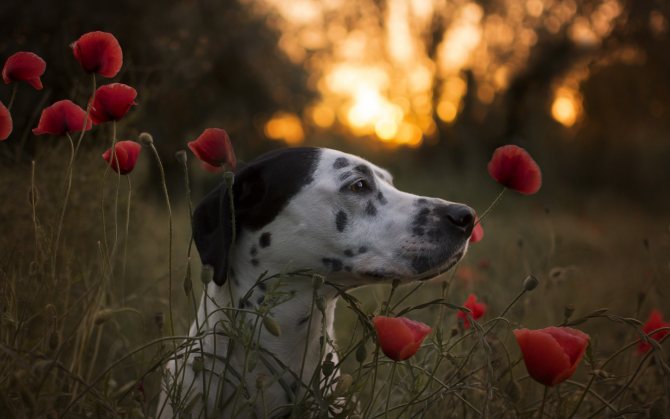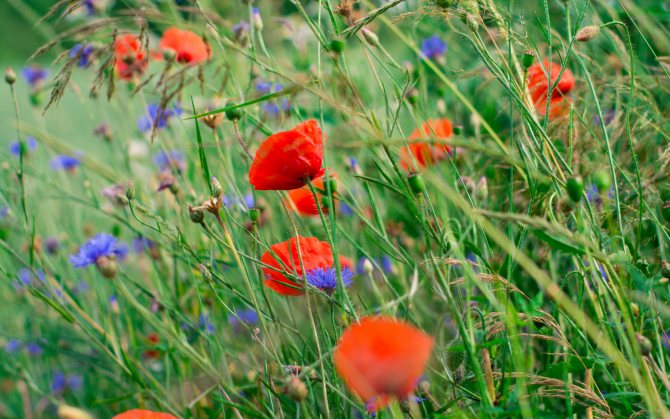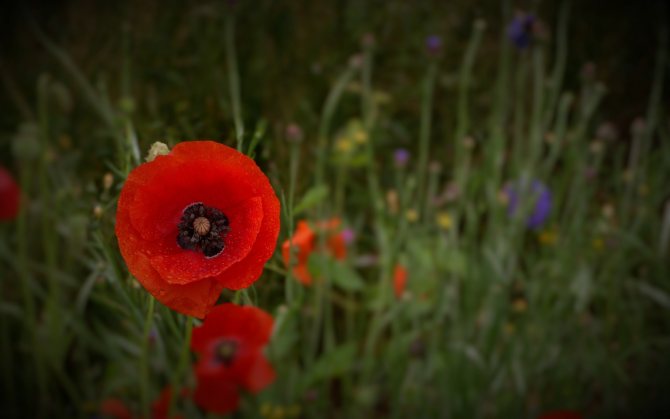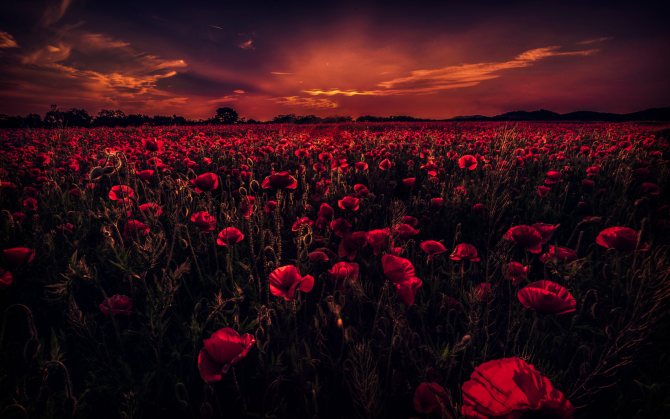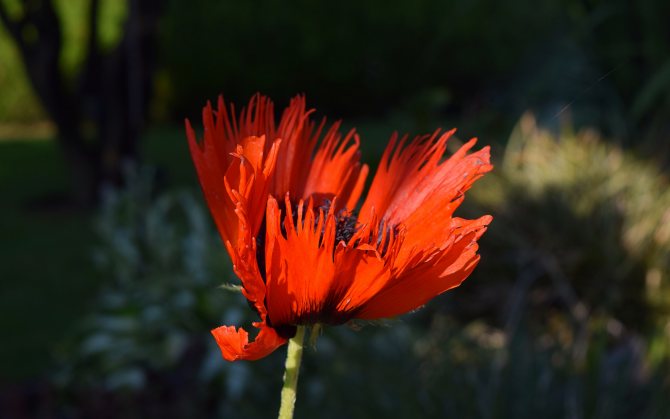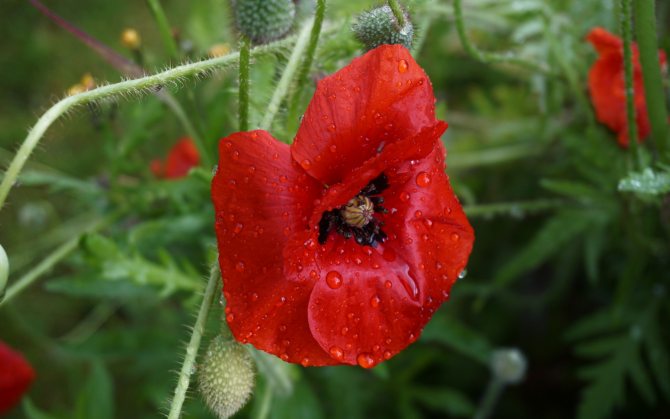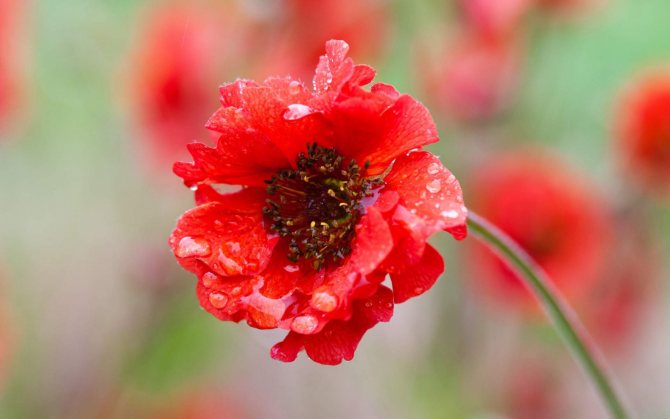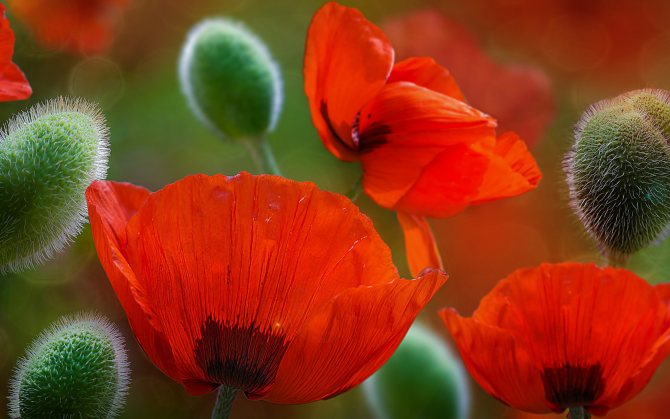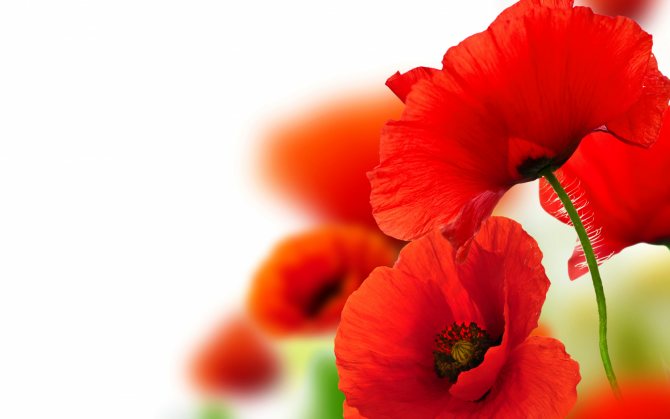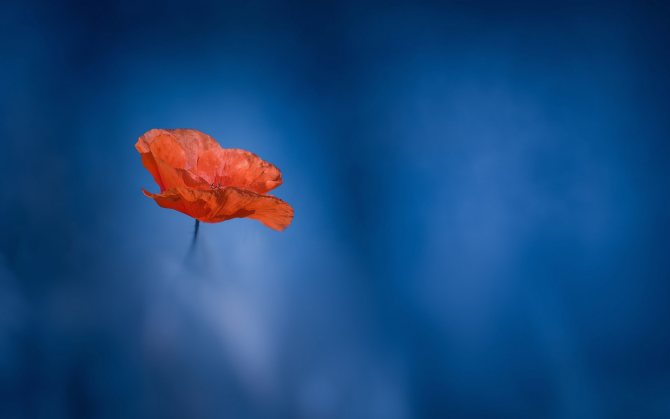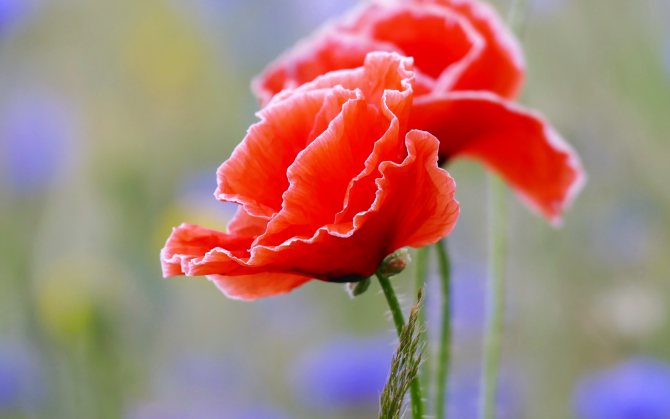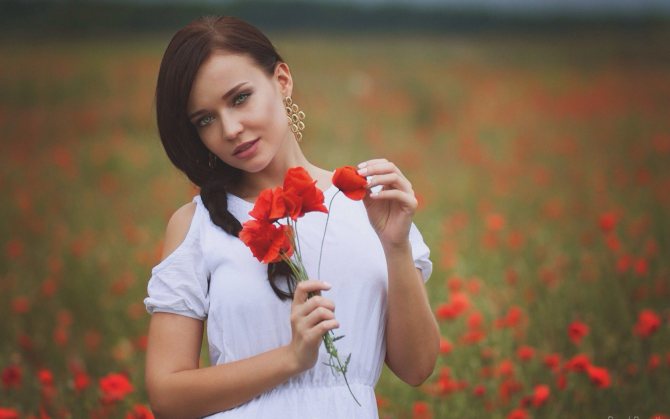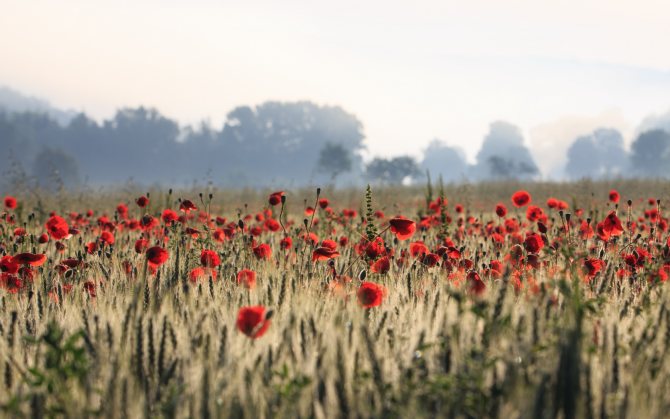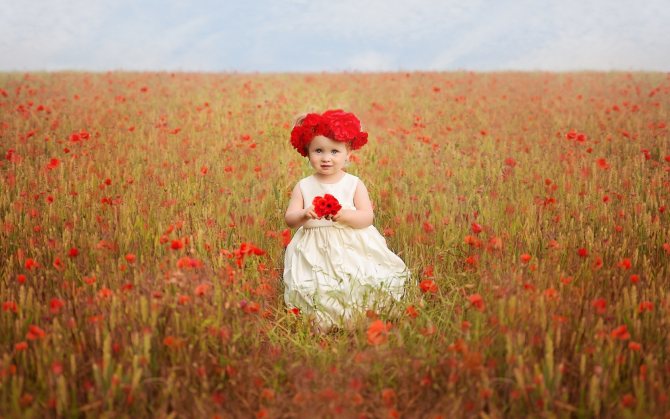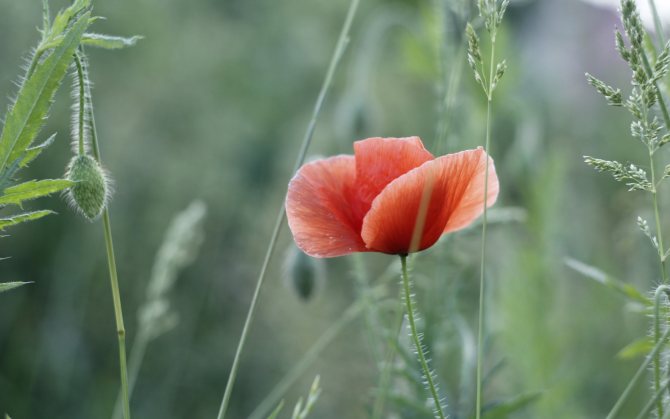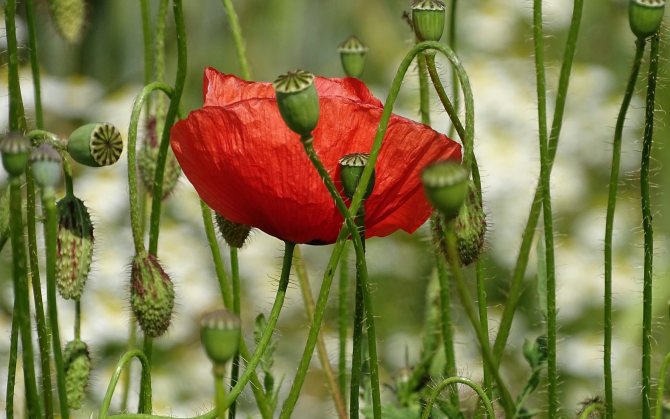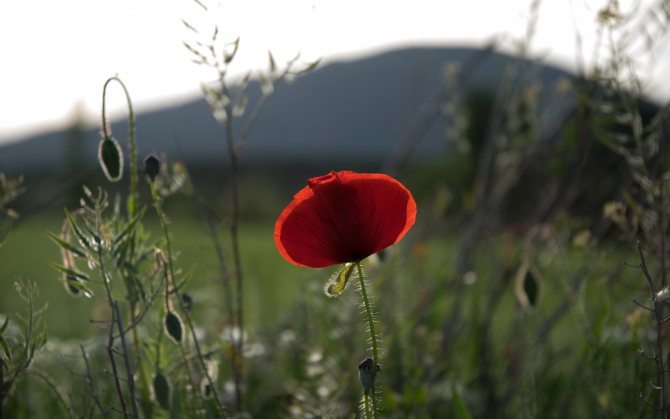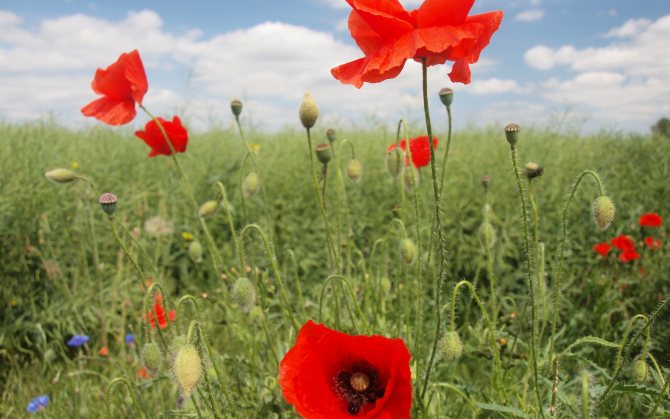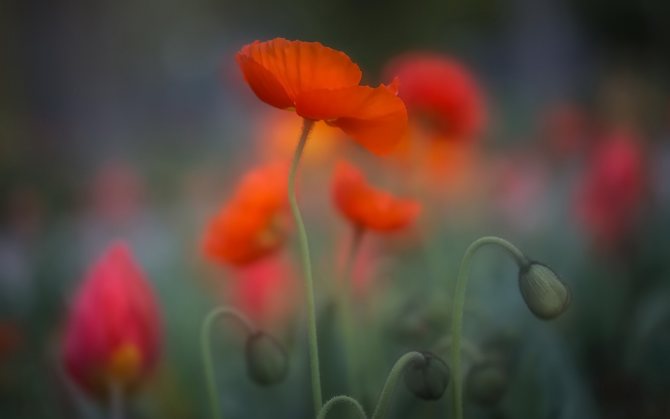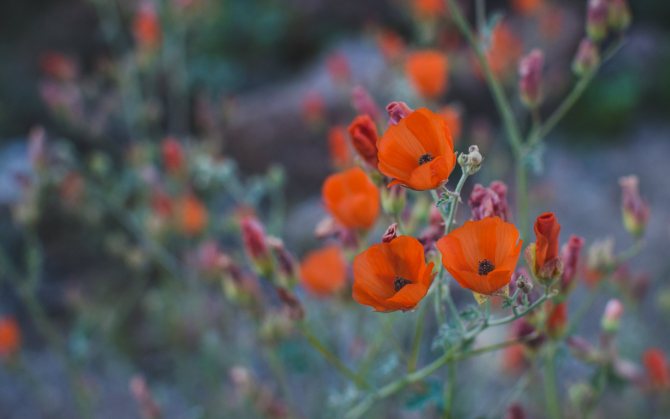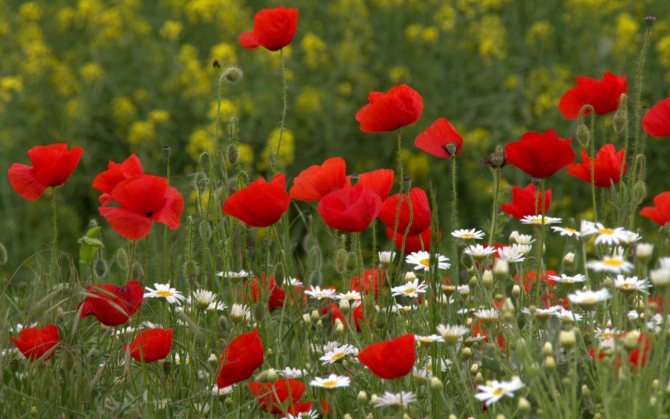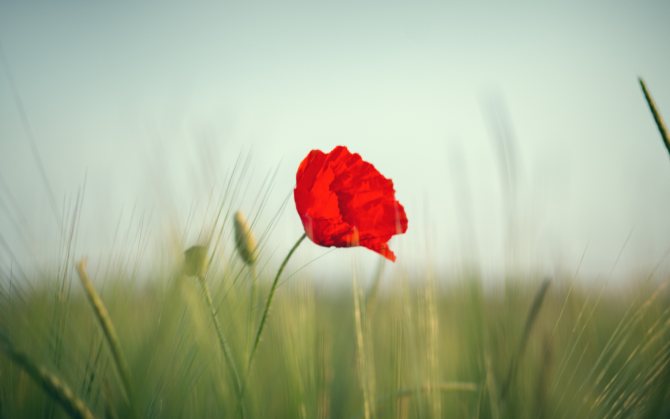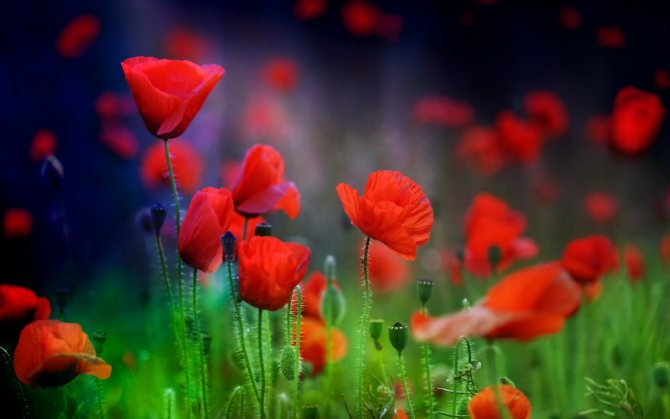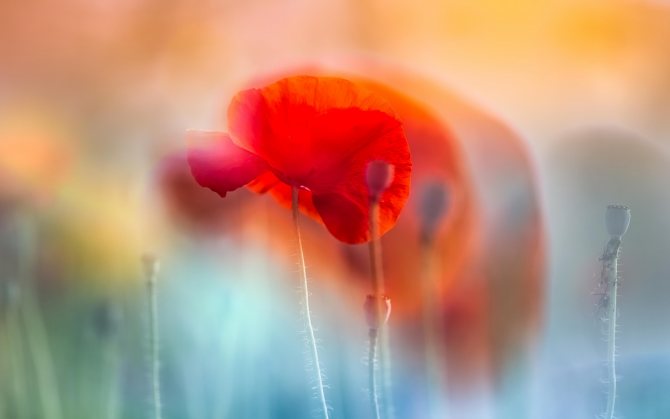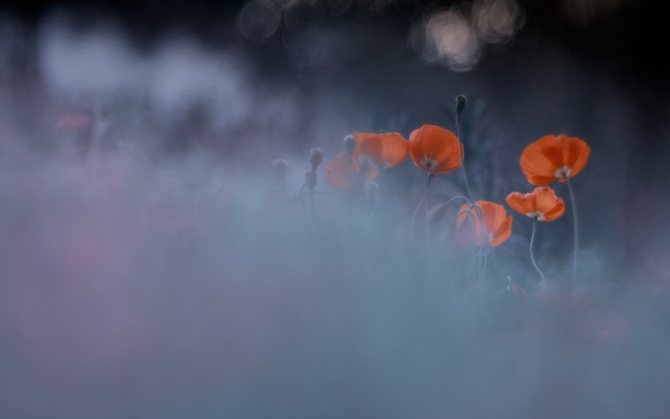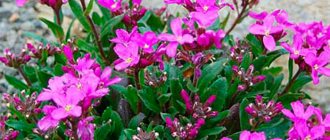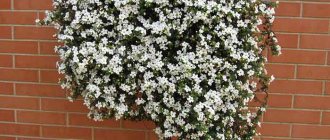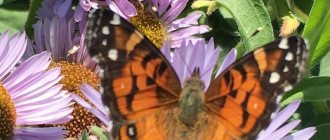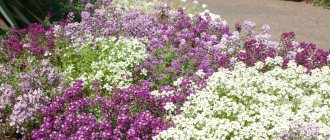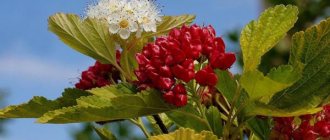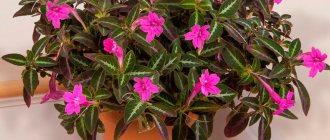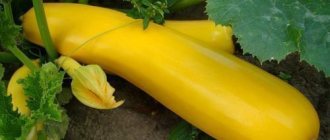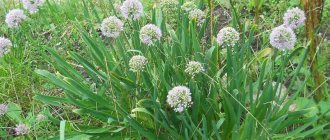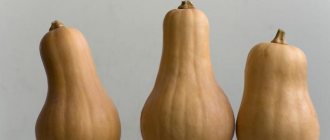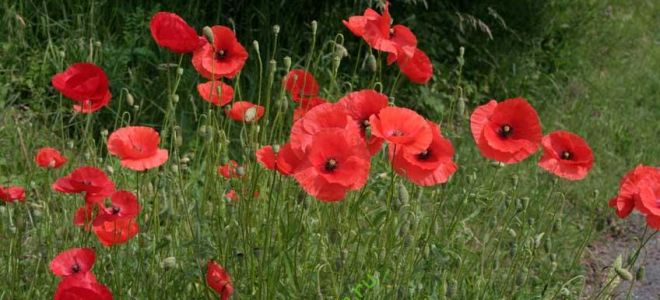
Poppy flowers have a long history of medicinal use, especially in the treatment of diseases in the elderly and children. Poppy is mainly used as a mild pain reliever to treat an irritable cough, it also helps to reduce excessive nervous activity. Unlike the associated opium poppy (Papaver somniferum), it is not addictive.
- Other uses for poppy
California poppies
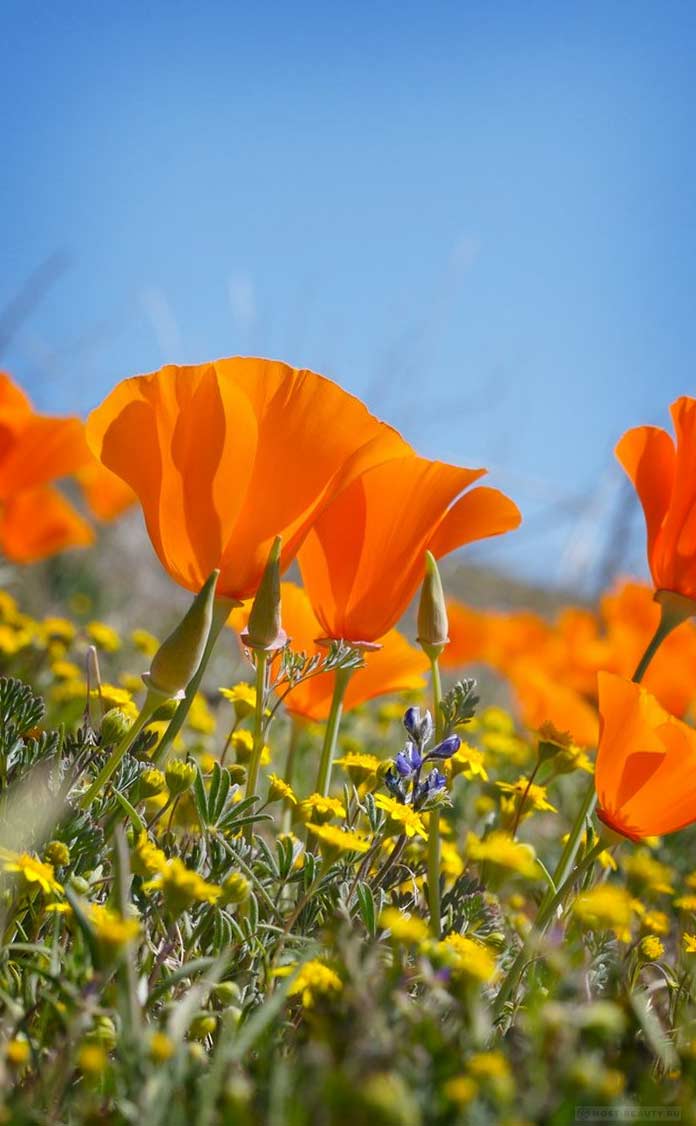

This variety of the most beautiful poppies was first discovered in the 18th century on the Pacific coast of California. The geography of growth gave them a specific name, and the second name - escholzia, these poppies received in honor of the famous naturalist.
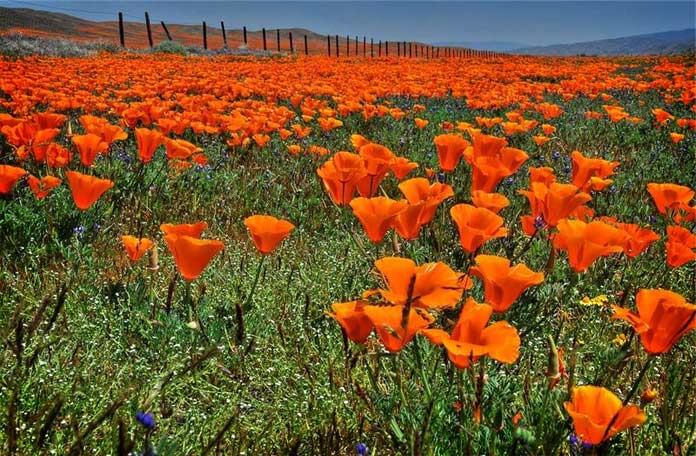

The California poppy is a small creeping plant, no more than 30 cm tall, most often with orange (less often pink and purple) flowers. Illuminated by the rays of the sun, these gorgeous flowers are like gold, for which they are called the "golden bowl".
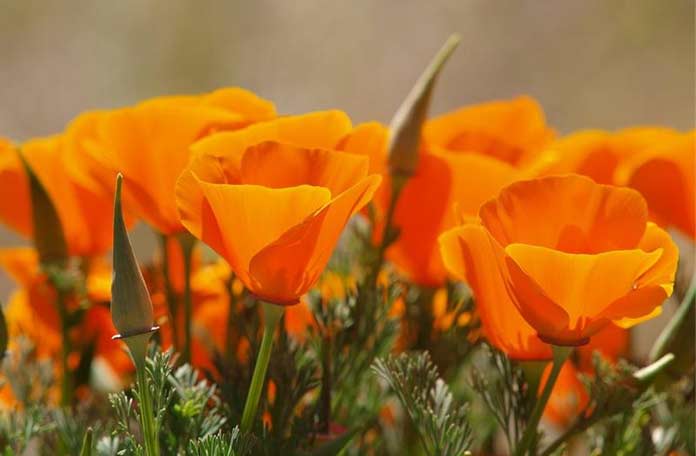

In landscape design, they are most often used to decorate borders and flower beds, combining with cornflowers and lavender, or they use only escholzia, but in different colors. Californian poppies bloom until late autumn, recalling the hot summer with their fiery color.
Edible poppy parts
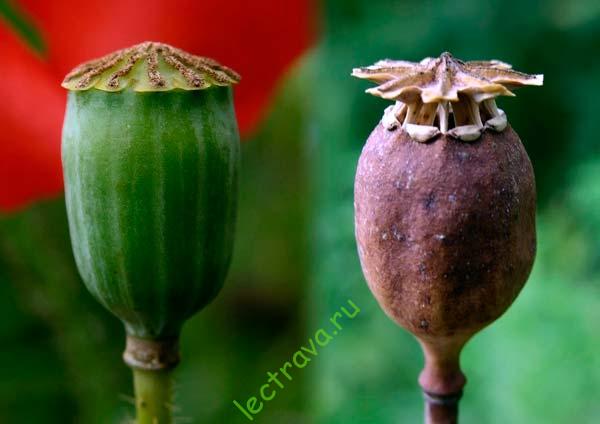

Seeds - used as a raw material for medicines or in cooking. Many people use them as a flavoring agent in cakes, breads, fruit salads, etc., and it imparts a very pleasant nutty flavor.
The seeds are quite small, but they are contained in fairly large seed pods, so they are easy to harvest. Poppy seeds are completely safe to eat, as they do not contain any of the alkaloids associated with other parts of the plant.
Leaves - used in cooking and medicine. Used as a herb or as a seasoning in soups and salads. The leaves should not be used after the flower buds have formed. Caution is advised as they are toxic. Edible oil is also obtained from poppy seeds. It is said to be a great substitute for olive oil, and can be used as a salad dressing or for cooking. The syrup can be obtained from scarlet flower petals, it is used in soups, cereals, etc. Red petal dye is used as food flavoring, especially in wine.
Other uses for poppy
The red dye is obtained from flowers, although they appear very fleetingly. Petal molasses is used as a dye for old paints. Red petals are used to add color to aromatic blends.
Dangerous properties of self-seeding poppy: this plant is toxic to mammals, although toxicity is low. The seeds are non-toxic.
The samoseyka poppy is one of the most famous wild flowers. It grows in the middle of a field of ripe golden corn, and is also often found on the roadside. A robust annual plant, grows with bright red single flowers, with or without black spot at the base of the petals, throughout the summer. The juice is milky white. And you can easily recognize the poppy seed from the photo.
There are hybrids of various colors, including white, pink and lilac, we can safely say that the samoseyka poppy is one of the most recognizable wild flowers.There is also a special poppy shirli, a pion-shaped samoseyka. It grows in poor soils, in dry conditions, and is suitable for wild gardens or flower lawns and requires little maintenance.
Poppy seed is used in traditional medicine to relieve pain, treat coughs and insomnia, and to aid digestion. The petals are used for colored medicines.
There is a similar plant, the dubious (long-headed) poppy, which is slightly smaller in stature, has a longer and more cylindrical seed box and often has yellow sap.
Oriental poppies
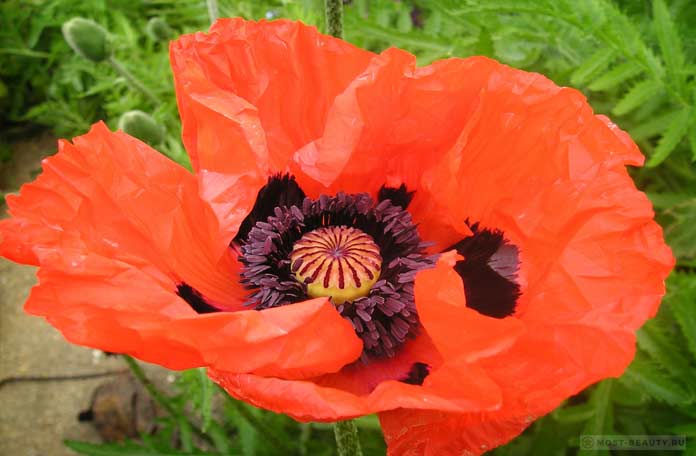

This most striking variety of beautiful poppies is a decorative flower up to 90 cm high. Its enchanting fiery beauty, like a flame, attracts the eye.
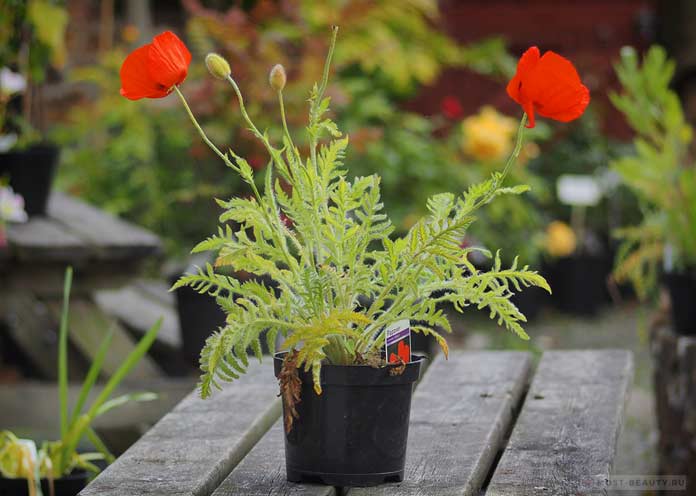

Occasionally there are pink and crimson shades of these poppies. The attractive beauty of the flower is very short-lived - after 3 days the petals fall off.
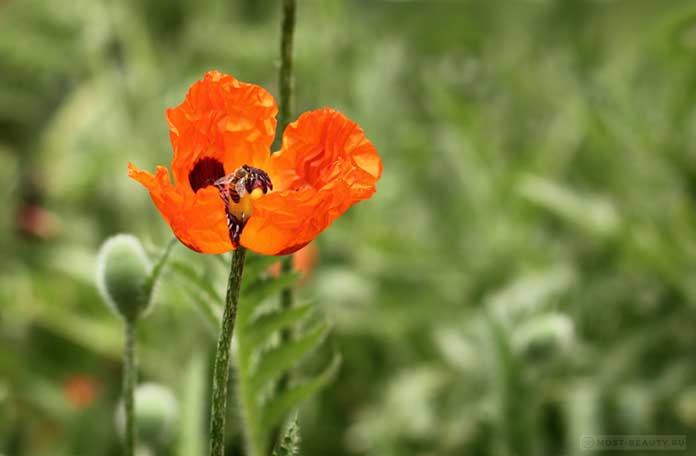

In the wild, the riot of colors of oriental poppies can be observed in Central Asia, in the meadows of the Caucasus.
Description of the plant
The peony poppy can be found under the name of the dense poppy or, in most cases, the papaver (Papaver). This terry type of poppy belongs to the Poppy family.
Why is the plant called papaver and not just poppy? This is due to the introduction of amendments to legislative acts that affect the cultivation of narcotic plants. Some types of poppy contain intoxicating, hallucinogenic, intoxicating and hypnotic substances: the cultivation of such plants in Russia is prohibited. Only 4 types of poppy have a destructive effect on the body. But often almost all types of this beautiful plant fall under the ban. It is forbidden not only to grow, but also to sell the seeds of this crop. Many, without delving into the text of the law and fearing to be fined, simply deny themselves the pleasure of planting these wonderful flowers in their garden.
Since the name of the plant "poppy" alone is associated with criminal liability and prison for many, seed producers and breeders have come up with a way out of this situation. Poppy, which does not contain narcotic substances, began to be called by the Latin name “papaver”.
Peony poppy is a herbaceous annual plant no more than 90 cm high. It forms small bushes with a powerful taproot system. The stem is erect, long, slightly branched, gray-green in color. The leaves are irregularly toothed-lobed, the same color as the stem, arranged in the next order.
Peduncles are tall, glabrous or slightly leafy. Single buds are formed at the tops: flowers are large, double, with numerous whole-edged petals. It is because of the resemblance to the lush flowers of peonies that this garden form got its name. The pink color of the buds predominates, however, many varietal forms with other amazing shades have been bred. The flowering period is June and July and lasts about 30 days.


After pollination, a fruit is formed - a capsule containing many small, rounded, dark seeds.
If you do not pay due attention to the plant and do not control its population, then thanks to self-seeding, the peony poppy is able to quickly spread to the nearby territory.
The peony poppy is a fairly common flower in nature. It is found on the plains and mountain slopes of temperate and subtropical regions of Europe, Asia, the Caucasus and North America.
Field poppies
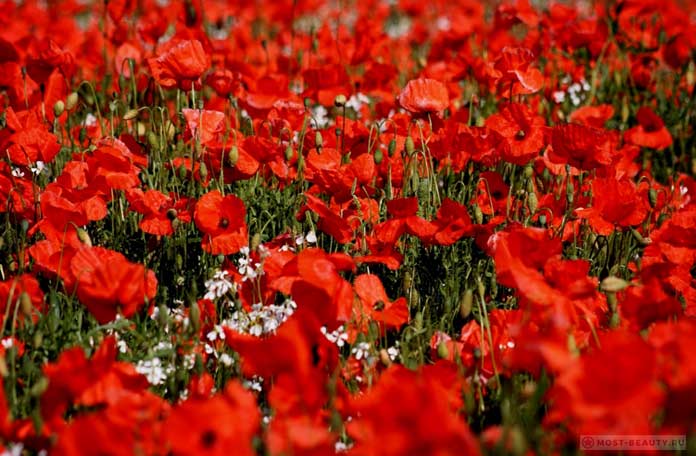

A fire flower or a poppy seed (aka field) is the brightest representative of these flowers, growing in the wild.


The area of its growth is very wide: from North Africa and Western Asia to various parts of Europe.
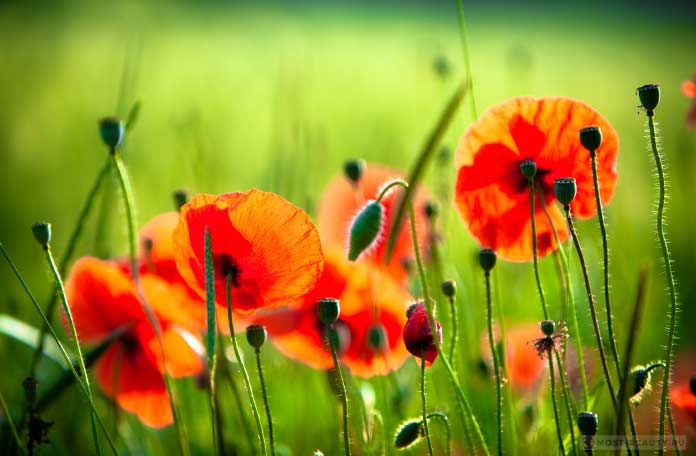

The firefields of the self-seeding poppy are most often found on arable land and near roads, less often on rocky slopes.
Poppy-samoseyka medicinal use and photo
Poppy seed plants do contain alkaloids that are still under research, so should only be used under the supervision of a qualified herbalist. Poppy flowers and petals are used as a pain reliever, emollient and stimulant of menstruation, expectorant, hypnotic, slightly narcotic and sedative. The infusion is taken orally for the treatment of bronchial diseases, coughs, insomnia, poor digestion, severe digestive disorders and minor painful conditions.
Poppy flowers are also used to treat jaundice. The petals are collected and dried for later use. They must be harvested in dry weather, and can be dried for later consumption or used to make syrup. The seed in the seed pods is a drug and mild sedative. Self-seeding poppy is used in very small quantities, as a drug that induces sleep and is under the supervision of experts. Leaves and seeds are used with tonic. They are helpful in treating mild fever. It also has anti-cancer properties.
Description of the plant:
- annual plants;
- height: 60 cm;
- bloom: from June to August.
Grass habitat:
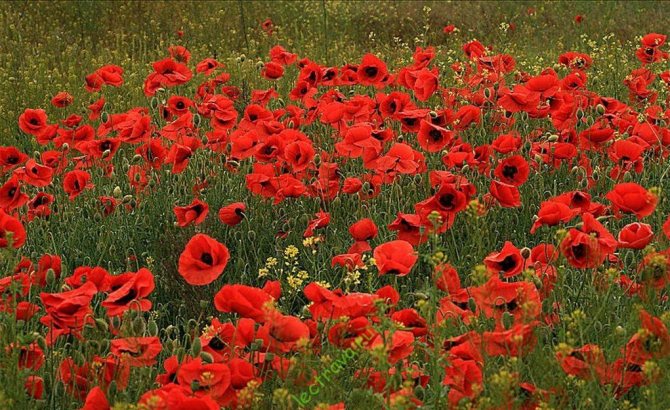

Like a common weed, poppy grows on arable land, worked-out places, avoids acidic soils. Has become much less likely to appear on cultivated land due to modern agricultural activities.
Polar poppies
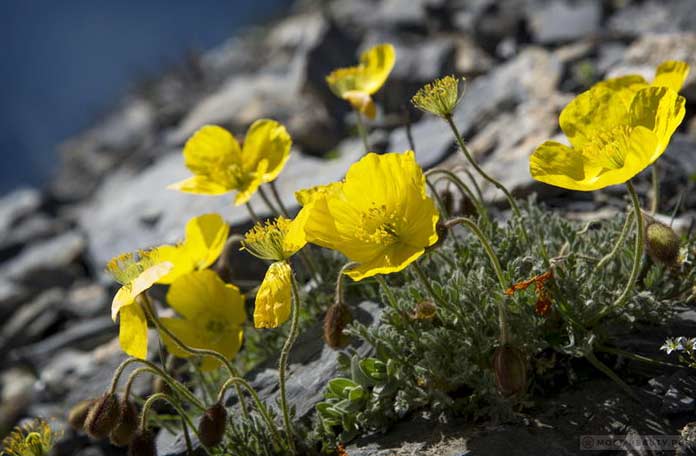

The most amazing creation of nature is the polar poppies, whose bright yellow flowers adorn the Arctic expanses. These beautiful flowers, reminiscent of the reflections of the sun, grow on rocky slopes unsuitable for vegetation.
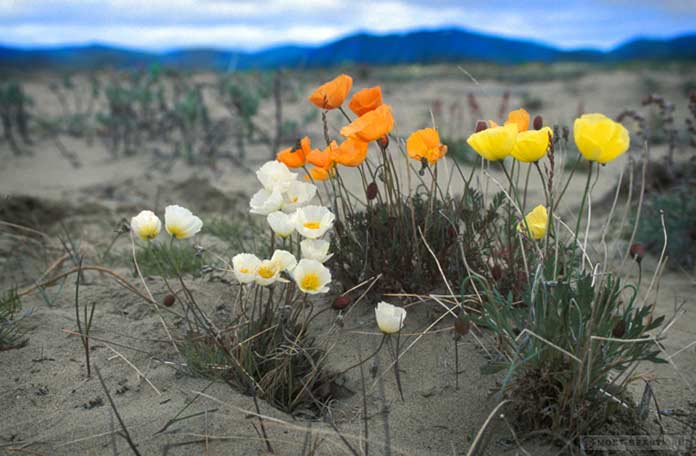

Conquering their living space in an inhospitable climate, they creep along the ground, creating real golden carpets.
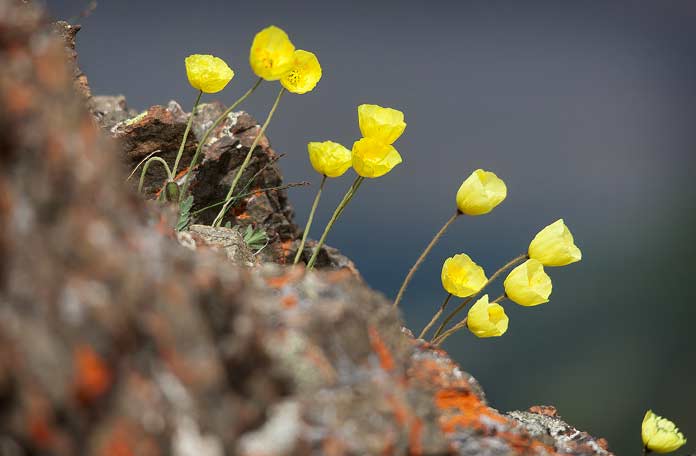

It is surprising that these flowers are also found on Baikal Olkhon. Fragile, delicate and incredibly hardy polar poppies delight everyone who has had a chance to admire this miracle of northern nature.
Care
The care is simple - it includes watering, feeding, mulching. Poppy loves organics and minerals. From this, the bushes and flowers become colorful and large. It actively grows up to 7-10 years, then a rejuvenating transplant is needed.
The soil
Oriental poppy loves loose garden sod with neutral or slightly acidic pH. Grows well on:
- Loam;
- Sandy loam;
- Clays.
Responsive to fertile lands. Does not tolerate increased dampness and humidity. Sand, peat, compost, lime are added to the soil.
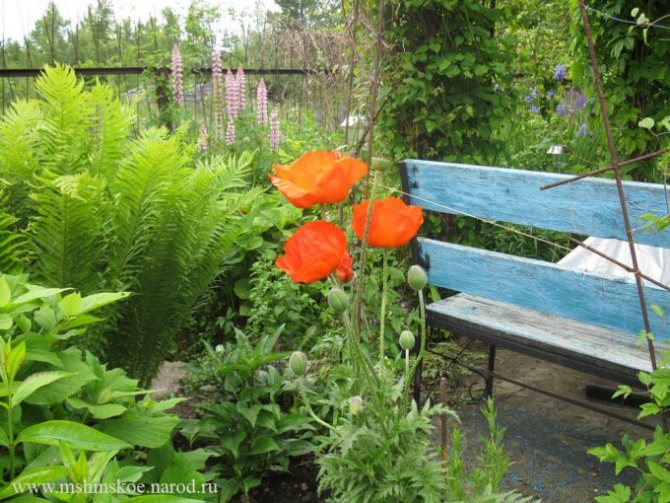

The close surface location of groundwater leads to decay of roots and death of flowers. The poppy has a long taproot and provides good drainage for good growth. Spread out branches, expanded clay, fine gravel and stones.
Watering
The flower needs infrequent watering at the root. Irrigation and sprinkling is undesirable - petals are damaged. Waterlogging and stagnation of water is dangerous - roots rot, fungus joins. In the dry season, the frequency of watering is once every 10-12 days.
Top dressing
For the formation of strong bushes, organics and minerals are used. Top dressing is carried out in the following order:
- First. During the growing season. Watered with diluted nitroammophos at the rate of 30 grams per 10 liters;
- Second. A week before flowering. Use a phosphorus-potassium composition in a dilution of 30 grams per 10 liters;
- Third. In two weeks. The mother liquor is introduced 1 liter per 10 liters.
Loosening and mulching
After rains and watering, the soil is loosened in 2-3 days. To prevent the formation of a crust, mulch with hay, straw, sawdust. Lay a layer of mulch 5-6 cm.
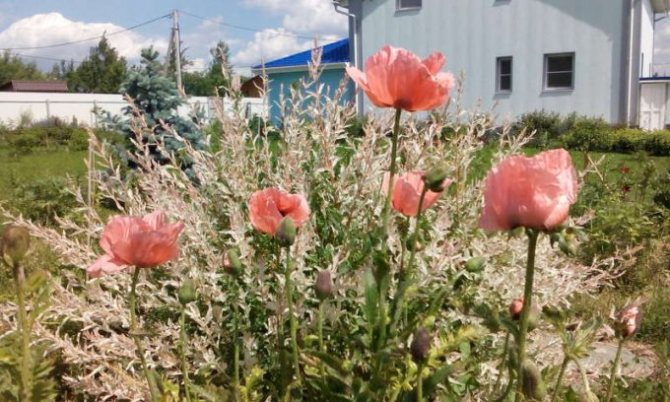

Bloom extension
Flowering can be artificially extended - for this, the seed pods are removed while still green. If you need to collect seeds, leave a couple of fruits.
Pruning
After flowering is complete, shoots and peduncles are cut off at the level of the soil surface - 1 cm above the root. Pruning dates - late July, early August.After the procedure, new leaf growth is started. In warm climates, a second bloom is possible.
Wintering
Oriental poppy is frost-hardy and does not need shelter for the winter in temperate and southern regions. In northern conditions, poppies can freeze out, paws of conifers, sawdust are used for shelter.
Himalayan blue poppies
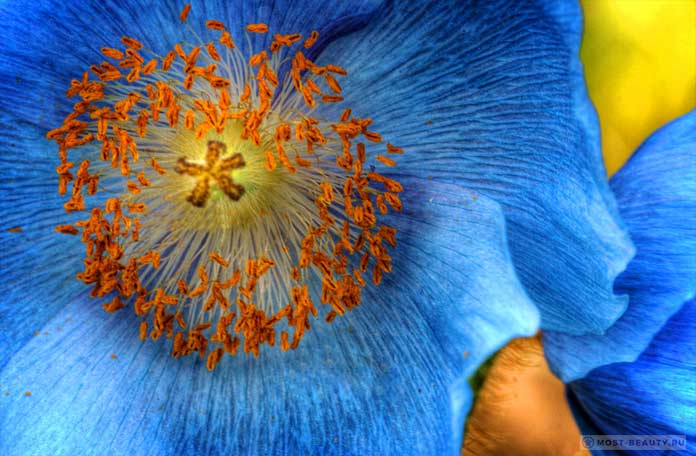

Looking at the glades of beautiful blue poppies, it seems as if an azure lake stretches out in front of your gaze. This illusion is especially strong in the natural growing conditions of these flowers - the Himalayan mountains, hence their specific name.
Often, blue poppies are called Tibetan (in Bhutan they are considered a national symbol and the embodiment of the harmony of the world) or bell-shaped (for blue), and in landscape design they are known as meconopsis. In the wild, these beautiful flowers grow in alpine meadows at an altitude of over 3000 m. They are also poetically referred to as the "blue sun of Tibet". In landscape design, flower beds and rockeries are decorated with these flowers, but growing them is not an easy task.
Growing
Plant in sunny, well-drained areas, although P. atlantkum and P. rupifragrum will tolerate partial shade. Sow annuals sparsely in a permanent place and provide a support at the time of flowering.
They do not tolerate transplantation well, with the exception of P. nudicaule.
Plant perennials in spring. Feed large plants with bone meal or mulch with well-rotted manure. The established species, except P. lateritium and P. orientale, do not like to be disturbed.
Garden poppies
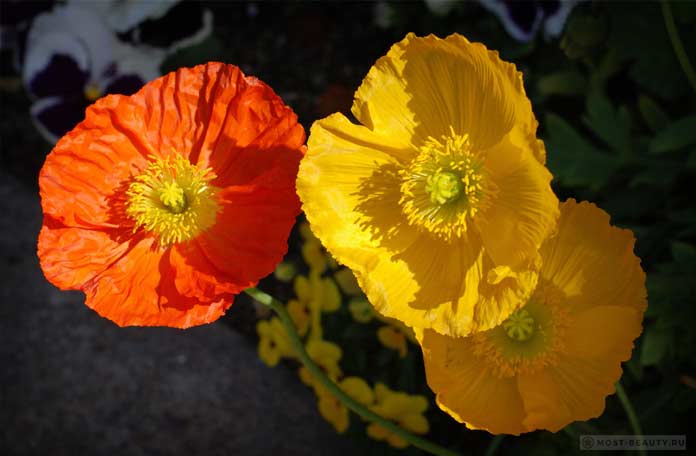

These plants have large flowers of various colors and can reach a height of 20 to 120 cm.
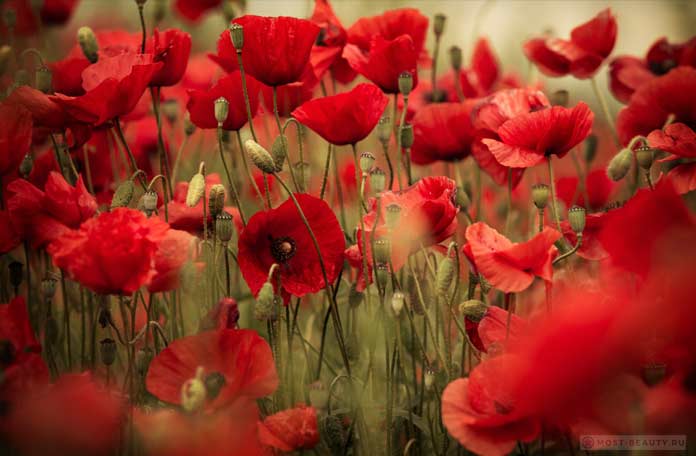

There are garden poppies with simple and double petals. The second variety impresses with more lush, but less durable flowering.
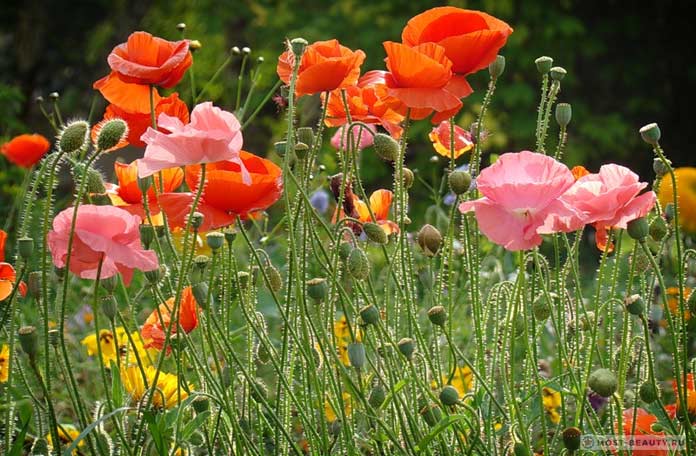

The decorative poppies in the gardens are a mesmerizing sight during the flowering period.
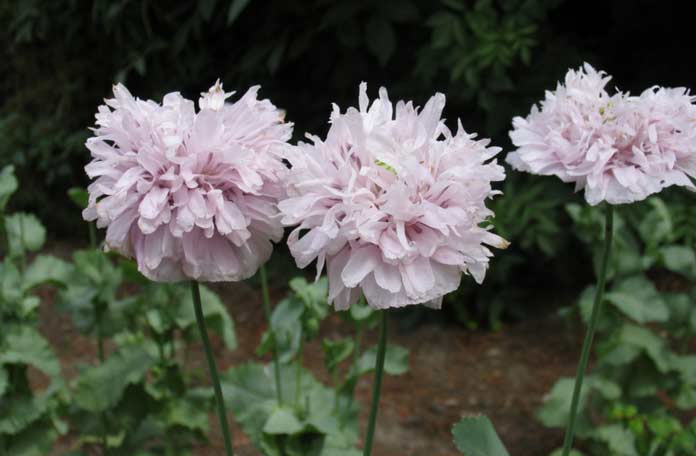

To prolong the possibility of contemplating a riot of bright colors, garden poppies are planted in batches at intervals of 10 days.
Landing.
Poppies are some of the easiest plants to grow. They are easy to plant and require little maintenance. Moreover, poppies are not demanding on the soil and can grow almost everywhere. But in order to get long flowering, and not have problems with pests and diseases, you should adhere to several rules.
- Before planting, you need to dig up the area and add some sand. Poppies thrive best on loose, well-drained soils.
- Poppies practically do not take root after transplantation, therefore it is recommended to sow them immediately in open ground - in early spring or before winter.
- Organic fertilizers are applied before planting.
- When the first shoots appear, they must be dived. The distance between shrubs is from 40 to 80 cm, depending on the variety. 10 reasons to eat apples every day How to delay old age or Prolong youth Anthurium flower is a capricious tropical beauty
Poppies in art
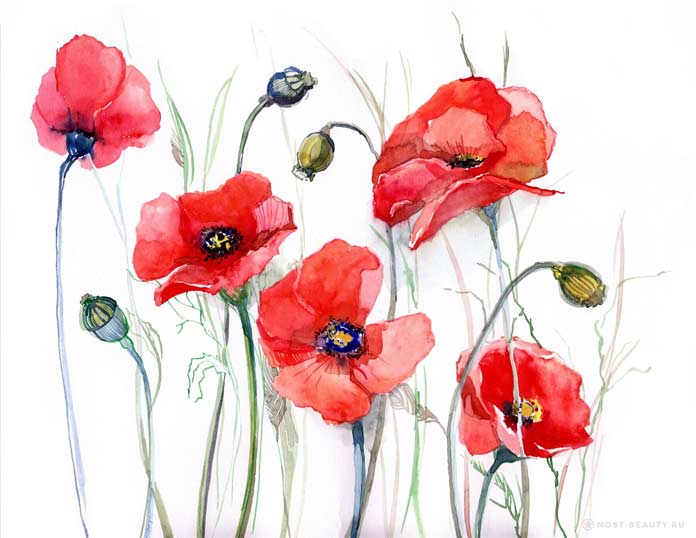

In Yorkshire, poppies are called "blinding blow" - for their enchanting beauty and intoxicating aroma, and in Provence they are considered the flowers of angels. Therefore, it is no surprise that photographers and artists draw inspiration from the picturesque fields of these colorful flowers, wanting to capture their fleeting beauty for a long time. Looking at the delightful poppies in watercolors, you will involuntarily believe that these flowers are a particle of a fiery flame that can melt the coldest hearts.
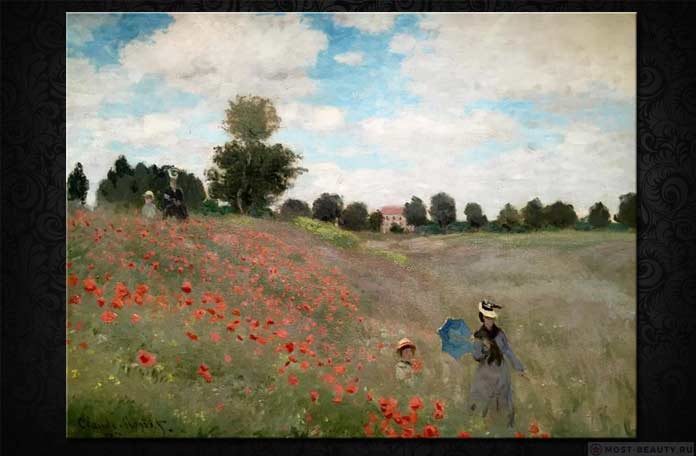

"Wild Poppies Near Argenteuil", Claude Monet, 1873
On many canvases of the brightest impressionist - Claude Monet, you can see fields of wild poppies. The most recognizable subject is the bright flashes of these colorful flowers in the artist's painting Wild Poppies near Argenteuil.
On the site you can see other beautiful paintings by Claude Monet.
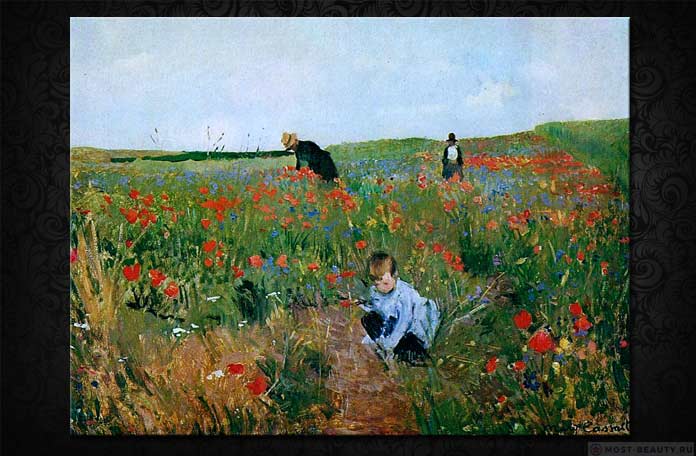

Red Poppies, oil, Mary Cassatt, 1880
Critics reproached Mary Cassatt that her canvases were too bright to correspond to reality. But looking at the work "Red Poppies", it is impossible to agree with this - the riot of colors of the poppy field conquers at first sight. The legendary Van Gogh also admired the fields of fiery flowers.
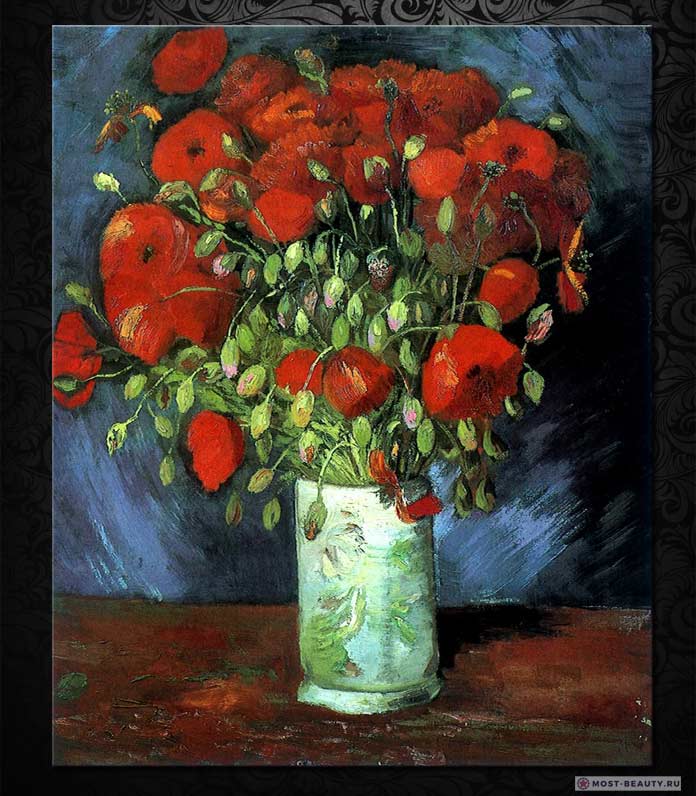

"Vase with Red Poppies", Van Gogh, 1886
Contemporary artists also do not remain indifferent to the beauty of fiery red flowers.
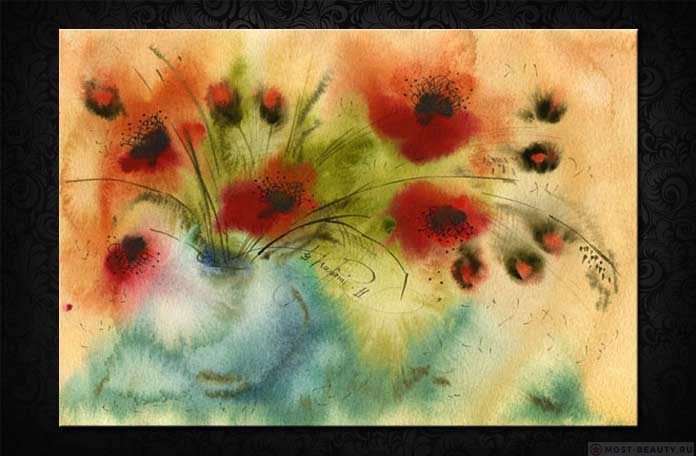

"Poppies", watercolor, Victoria Kirdiy
Poppies in Victoria Kirdiy's watercolors, depicted in the fields next to gray dandelions or in bouquets with daisies, impress with their tenderness and airiness. They seem to serve as a reminder that life is fleeting, and it is worth taking pauses to notice bright moments.
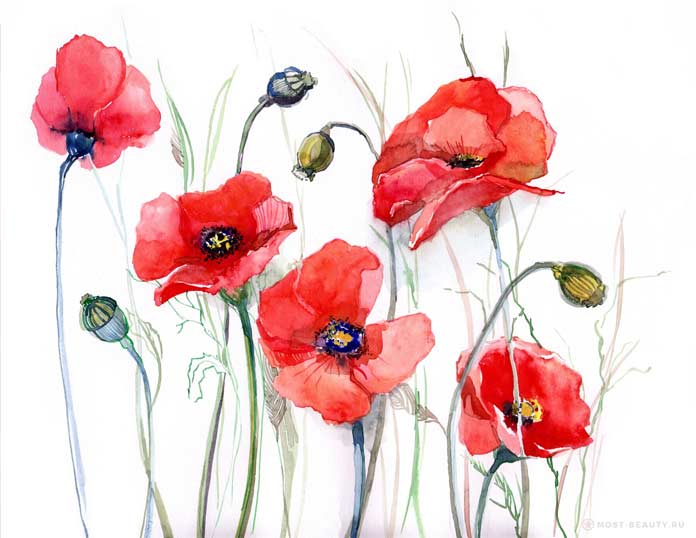

Floral calendar. June: bells poppies
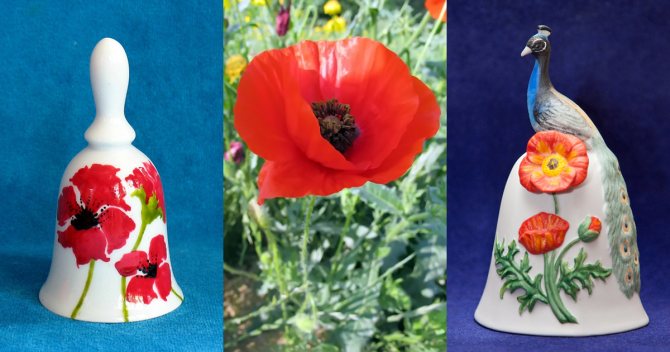

Poppy. Handsome and cunning
Collecting information about poppy seeds, I came across the fact that there is a lot of it and it concerns various areas: floriculture, myths and legends, folk rituals, medicine, cooking, fortune telling, poetry, art ...
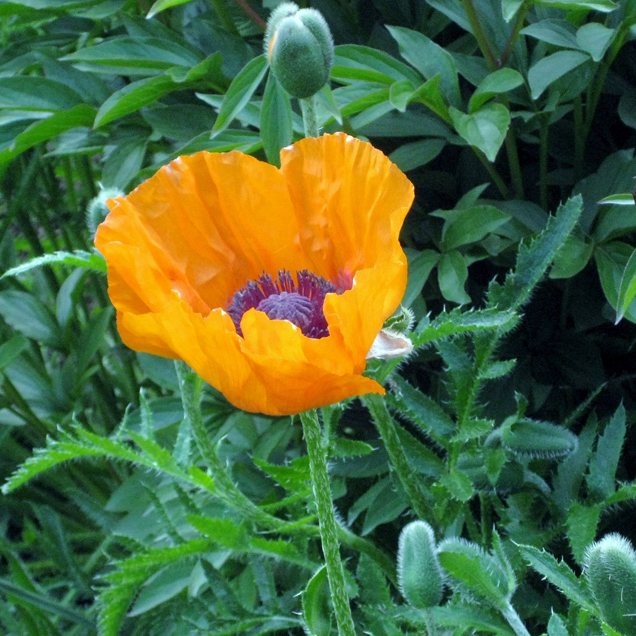

Photo by A. Salkutsan
Perhaps because poppy is one of the oldest cultivated plants in the world and one of the oldest spices. Poppy began to be cultivated in Central Asia and Europe in the Neolithic era.
Bell. Collection A. Salkutsan
Bell. Collection A. Salkutsan
This plant is very interesting, both in appearance and in its properties. Poppy is a mythopoetic image - a sign of sleep and death, and a blooming one - of unprecedented beauty, also a symbol of unfading youth and female charm.
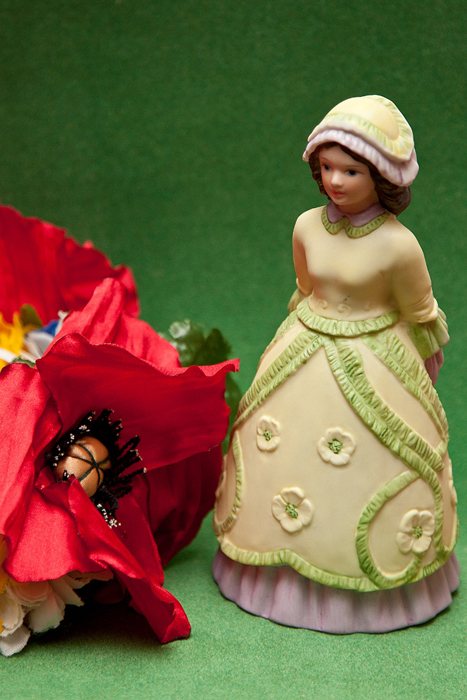

Bell from the collection of Y. Churilova
Poppy has long been considered the flower of sleep and oblivion. This flower is an attribute of the god of sleep Hypnos and the god of death Thanatos. The kingdom of the god of dreams Morpheus was planted with poppies. The goddess of the harvest, Ceres, was always depicted with a poppy in her hand. Poppy served as a symbol of fertility because of its high fertility (the poppy box contains about 30 thousand seeds). Therefore, he is an attribute of Hera (Juno) - the goddess of fertility and marriage.
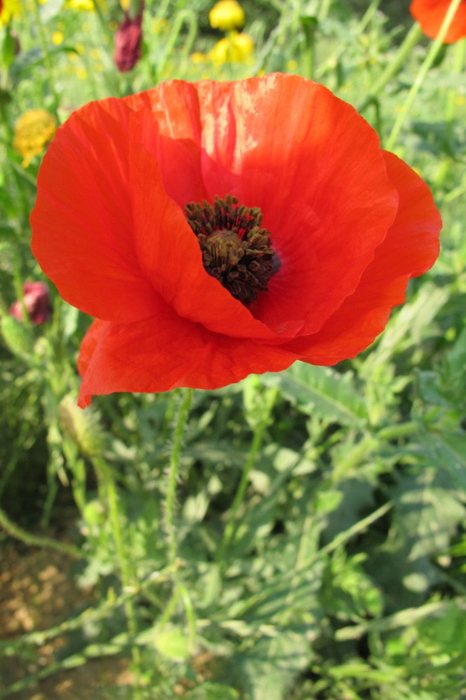

Photo by N. Stepanova
There are several legends associated with the emergence of the poppy. The ancient Greeks believed that this flower was created by the god of sleep, Hypnos, for Demeter to fall asleep and rest from the search for her kidnapped daughter Persephone. The ancient Romans believed that the poppy grew out of the tears of Venus, which she shed upon learning of the death of the beautiful young man Adonis. According to Buddhist legend, the poppy grew on the ground, which was touched by the eyelashes of the sleeping Buddha.
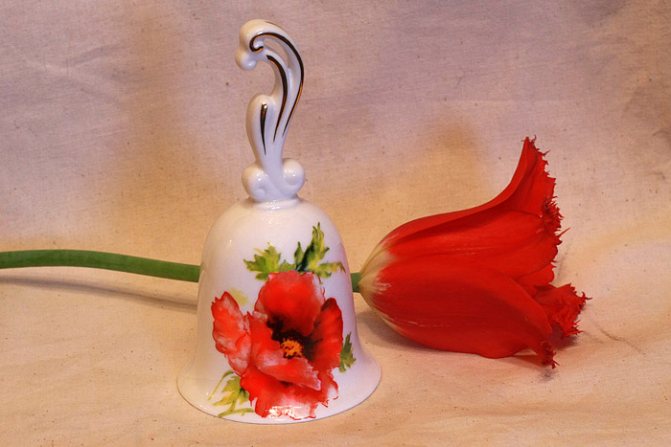

Bell from the collection of Y. Churilova
Poppy is grown for food, medicinal and decorative purposes in many countries of the world. All poppies can be divided into annuals and perennials. Annual poppies were once widespread in nature - they grew in fields, along roadsides. This is the so-called field poppy or self-seeding poppy. Such a poppy lives in the garden only one summer, but thanks to abundant seeding the next year it can again please with its flowering, sometimes in the most unexpected places in the garden. Samoseyka poppy seeds are loved by different rodents. They store poppy pods for the winter, while carrying the seeds of the plant over long distances. Of the perennial poppies, the most common in floriculture are oriental poppies and bracts.
The natural color of poppy flowers is bright red with a dark center, but today breeders have bred many varieties with different colors: white, purple, pale pink, cream, orange ... Poppies bloom in May-June for 20-30 days.
Bell from the collection of Y. Churilova
In the Middle Ages in Europe, poppy was grown in every peasant garden, as it was levied as a tax - each household had to donate approximately 27 liters of poppy seeds.
Poppy emits a rather strong stupefying smell, from which you can even fall asleep. As a result, in Germany there was a belief that someone who falls asleep in a poppy field falls ill with sleeping sickness.The German poet, B. Sigismund, describes the smell emitted by the poppy: "Sweet is the scent of violets, the scent of a rose is wonderful, the scent of cloves is hot as spicy wine, you emit an intoxicating smell, like the waters of the Lethe River, destroying the memories of a lived life."
In my favorite children's book, the heroes almost died when they got on a poppy field and inhaled the sweetish scent of red flowers. The chapter in the book by A.M. Volkova "The Wizard of the Emerald City" is called
Insidious poppy field
“The travelers walked merrily through the meadow dotted with magnificent blue and white flowers. Red poppies of unprecedented size with a very strong aroma were often found. ..
… The further the travelers went, the more poppies became in the field. All the other flowers disappeared, drowned out by the poppy bushes. And soon the travelers found themselves among the boundless poppy field. The smell of poppy lulls, but Ellie did not know this and continued walking, carelessly inhaling the sweetish soporific scent and admiring the huge red flowers. Her eyelids were heavy, and she wanted badly to sleep. However, the Tin Woodman would not let her lie down.
“We must hurry to reach the yellow brick road by nightfall,” he said, and the Scarecrow supported him.
They walked a few hundred more steps, but Ellie could no longer struggle with sleep - staggering, she sank among the poppies, closed her eyes with a sigh and fell fast asleep.
- What to do with her? The Woodman asked in bewilderment.
“If Ellie stays here, she will sleep until she dies,” the Lion said, yawning widely. "The scent of these flowers is deadly." ...
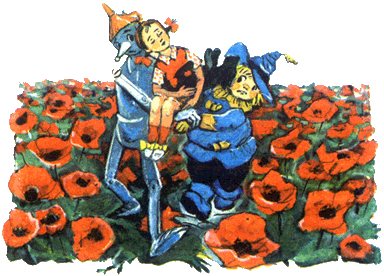

L.V. Vladimirsky, illustration for the book "The Wizard of the Emerald City"
Poppy is popular in folk medicine - it is used to treat headaches, bronchitis, bruises, sore joints, and is used as a sleeping pill and sedative. Many medicines are made on the basis of poppy: sleeping pills, analgesics, antispasmodics, antitussives and others. Nowadays, the healing properties of poppy are receding, unable to compete with synthetic analgesics. And in the foreground is the deadly juice of this flower, opium, a source of heroin, morphine and other dangerous drugs. But the flower is not to blame for anything. People who have lost their sense of proportion, do not feel the line between life and death are to blame.
Bell from the collection of N. Stepanova
Opium is obtained from sun-dried milky juice extracted from unripe opium poppy capsules. The first mentions of opium date back to 300 BC. e. It was used only for medicinal purposes as a sleeping pill and pain reliever in Ancient Egypt, Ancient Greece and Ancient Rome. Especially often they began to use opium as a medicine in the Middle Ages, and it often happened that a patient died from an excessively large dose of this medicine. Cases of poisoning became so frequent that the medieval doctor Tabernemontanus wrote the book "Magsamensaft" ("Poppy seed juice"), in which he advised the use of this remedy only in extreme cases and reproached doctors that, being carried away by the quick healing of this remedy, they did not think about the dire consequences that threaten their patients.
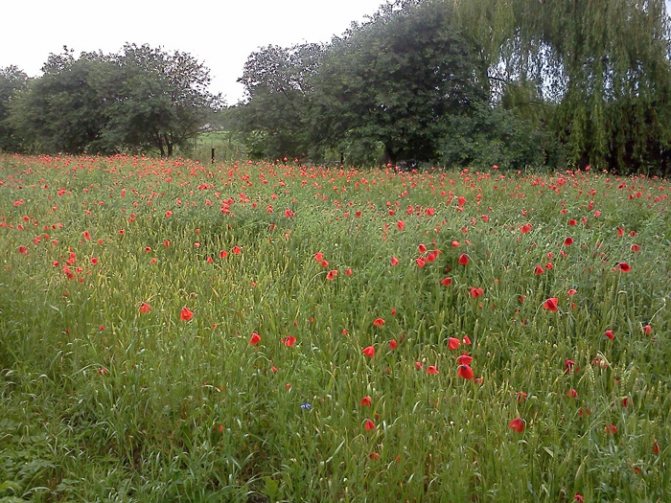

Photo by L. Franzek
Opium was first smoked in the East, in Muslim countries. Smoking opium became, as it were, a substitute for the use of alcoholic beverages prohibited in these countries under the law of Mohammed. Also, smoking opium was used for medicinal purposes, for example, Dutch sailors were convinced that smoking a mixture of tobacco and opium protected them from malaria.
Initially, Turkey and Arabia were engaged in the preparation of opium for smoking, but then India became the main center of its production, where the British, appreciating the benefits from the trade in this poison, began to breed it in huge quantities for export to the Mohammedan countries and especially to China, whose inhabitants, having tasted sweets of this smoking, they were carried away by it almost without exception. In 1820, the Chinese government banned the import of opium.But England, unleashed a war called "opium". The loser in this war, China was forced to again allow the import of opium, as a result of which the smoking of opium in China was widespread for a long time.
Bell from the collection of I. Koltakova
An old Indian legend tells of the consequences of this addiction, according to which those who use opium will have the qualities of different animals. At first, they will be playful and frisky, like a mouse, then - milk-loving, like a cat. For some period they will be fighting and yapping at everyone, like a dog, furious like a boar. Then - grimacing like a monkey, and, finally, majestic, like a queen ... But nevertheless, they will end their life by falling to the very bottom.
For "peaceful" purposes, poppy is widely used in cooking. Poppy seeds are high in fat, protein and sugar. Poppy is used for making halva, it is sprinkled with buns, crackers, dryers and other confectionery products. Poppy is also used to produce oil. The highest quality oil is used for food, the inferior quality oil is used for the preparation of varnishes, soaps and paints. Poppy seed cake is used to feed livestock and poultry.
In Russia, Ukraine, Germany, Poland and other countries, poppy is used for the preparation of ritual meals (kutia, poppy cakes, cakes with poppy seeds, poppy seeds). Poppy flowers and seeds are used in various rituals and church festivals. Many legends, signs and legends are associated with them.
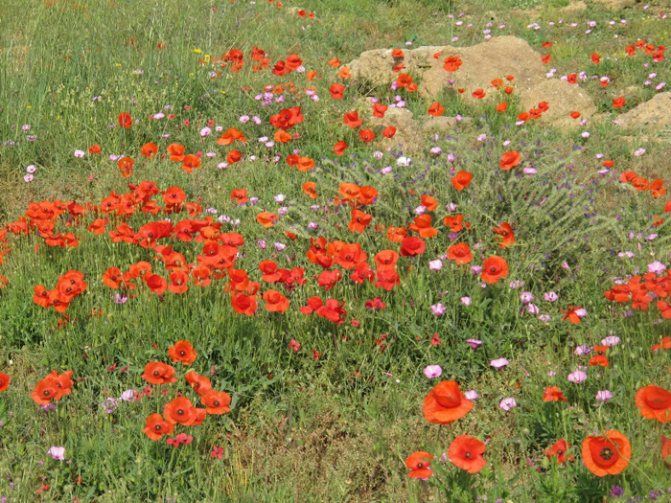

Photo by N. Stepanova
In Yorkshire - the poppy is called "blind blow", because the bright red color of the poppy is blinding, and "weak head", because the smell of its flowers is causing a headache. In Provence, the poppy is considered the flower of angels, because it is used to decorate churches on the day of the Descent of the Holy Spirit. In Flanders and Brabant, poppies are called "sprokelloem" - "flowers of ghosts", because there is a belief that you cannot go to the poppy fields, because its flowers suck blood. In China, poppies symbolized retirement, relaxation, beauty, success; however, as a source of opium - decay and evil. Picking up poppies seems to be a symbol of the impossibility of doing anything, or even a huge difficulty.
In Greece, the poppy was called "dylephilon" - "love spy", because the girls, tearing off its petals and placing them on the circle formed by the bent thumb and forefinger of the left hand, beat them with their palm and, by the force of the cotton, determined how much their lover was in love with them.
Photo by V. Leonov
In Russia, although poppy flowers do not have a special meaning in church festivals, church chapters are often called golden poppies. Here, of course, the name of the poppies refers more to the upper part of the head, which we usually call the "crown, poppy"; nevertheless, some symbolism arising from the similarity of the poppy head with our head is observed in many Russian sayings and songs.
This symbolism already existed among the ancient Greeks, who called the poppy - kodeion, and the human head - kodeia, and especially among the ancient Romans, in whom Numa, instead of human heads sacrificed to Jupiter in the past, began to sacrifice poppy heads. The same thing happened with the brutal propitiatory sacrifice of children's heads to the goddess Mania. Junius Brutus replaced the children's heads with heads of garlic and poppy seeds.
Bells | Flower calendar | Flowers
Girls and Poppies
This is exactly the case when 2 * 2 = 5. Very spectacular shots can be obtained when beautiful girls pose for a photo with beautiful flowers, and if we are talking about poppies, then it is difficult to spoil the photo. This technique is used by many popular Instagram bloggers.
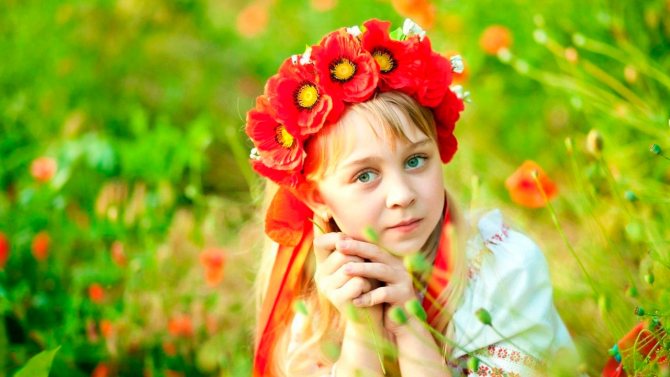

Possible growing difficulties
It is not difficult to grow a terry poppy, but many may face such problems as:
- too wet soil: excessive constant watering can cause wilting and death of the plant;
- poor soil: with a lack of nutrients in the soil, the bushes grow small, weak, the flowers are not very large and less bright;
- dense planting: the bushes are cramped, which affects the decorative appearance of the plant, they become smaller;
- poor care: if withered flowers are not cut off in time, they will cause seed bolls to appear. In this case, the bush completes the vegetative period and stops flowering. Pruning wilted flowers prolongs the flowering period of the bush;
- the wrong place for the plant: a too dark corner of the garden will cause the lack of buds.
Poppy fields
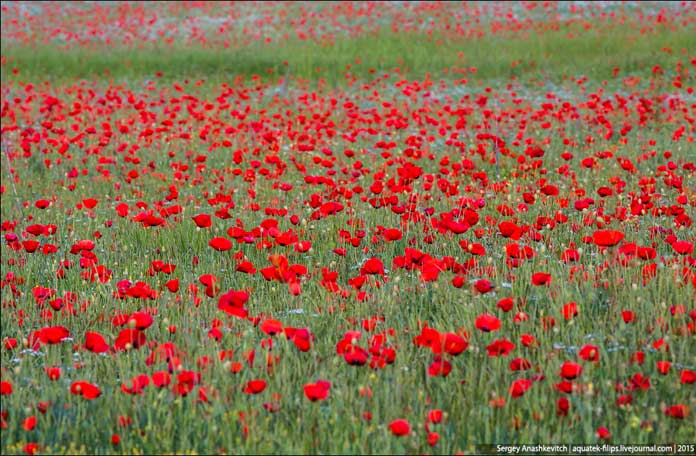

Poppy fields look especially impressive during the flowering period. Many tourists are looking forward to this moment in order to "hunt" for this amazing phenomenon.
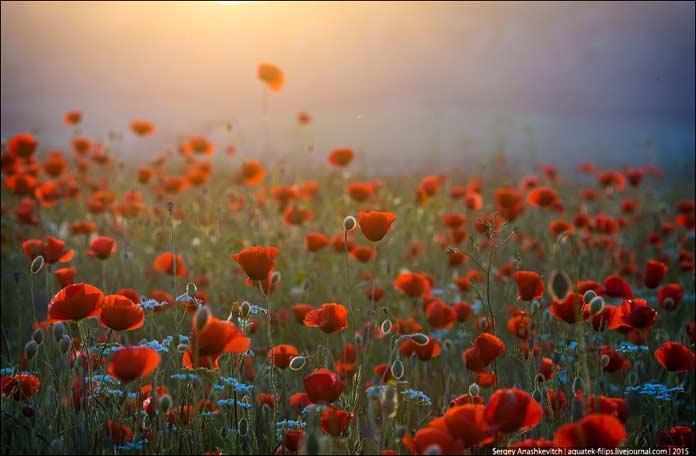

You can see in all its beauty the fields dotted with fiery flowers in Crimea. There are many fields in the Simferopol region, near Sevastopol, in the village of Tankovoye.
You can find fields in East Kazakhstan. Such amazing landscapes can be found in the spring near Alma-Ata.
In addition, beautiful flowering fields can be found in many parts of Europe.
Oriental poppy in landscape design
Poppies are planted in rose gardens, flower beds, flower beds, both in single and in group plantings. They act as accent on lawns. It is better to place them in the form of original islands in the background next to autumn perennials - asters, chrysanthemums. Interesting options are created with decorative tobacco and cochia. The flower looks spectacular:
- On the alpine slides;
- In mixborders;
- In rabatkas;
- On the lawns.
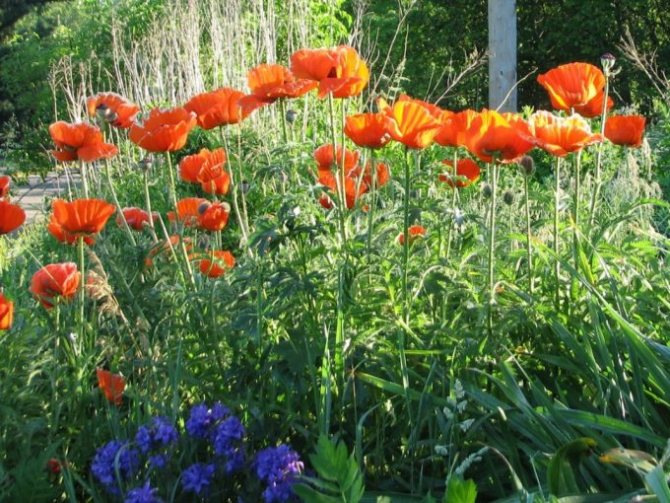

Colorful combinations are obtained by combining poppy with plants such as:
- Cornflowers;
- Rogers;
- Bells;
- Irises;
- Delphiniums;
- Hosts;
- Asters.
Partners are selected with snow-white, blue, crimson flowers. Garden geraniums, peach-leaved bells, and bows will do. Landscaping designers advise combining plantings for contrast with decorative grasses, ryegrass, daisy, yarrow, oregano. Leafy necklaces are created around the poppy. Nearby, it is useful to sow annuals and perennials, aquilegia, which will continue to decorate the flower bed after the poppy has faded. Lovely neighbors:
- Gypsophila;
- Rudbeckia;
- Catnip.
Manicure with poppies
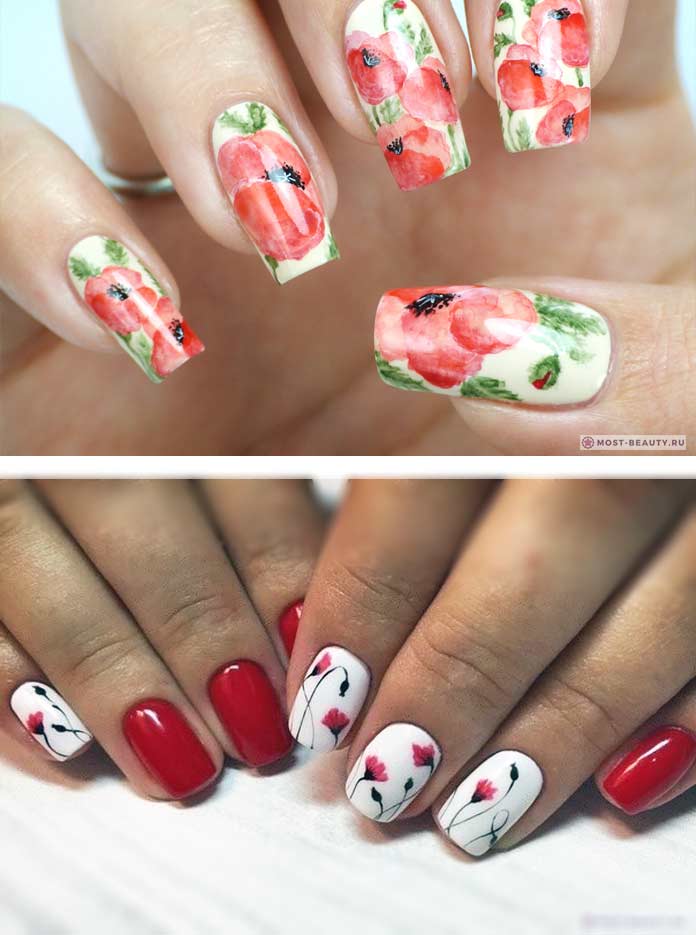

Ancient Greek myth says that poppies appeared from the tears of Aphrodite, who lost her beloved Adonis. A romantic halo has enveloped these beautiful flowers for a long time, so it is not surprising that they are often used in the design of women's jewelry and accessories, as well as in the creation of manicure.
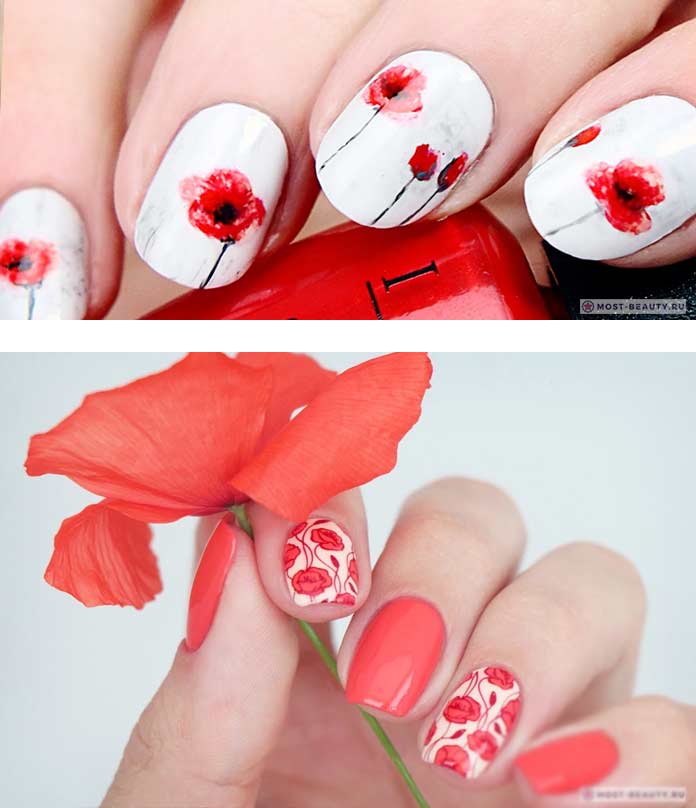

Nail art with poppies is chosen by romantic and extraordinary people who are not afraid to paint life with bright colors. Such floral motifs add femininity and mystery, and if you believe the signs, they are even able to attract love. In any case, such a manicure sets you in a positive mood and is unlikely to go unnoticed by others.
Diseases and pests: treatments
The plant can often be accompanied by various diseases:
- root rot;
- powdery mildew;
- fungus of black spot.
Much less often, terry poppy can become an object of attack by pests such as:
- aphid;
- spider mite.
Sometimes, if unwanted insects are found, it is enough to treat the bush several times with soapy water. For more severe damage, various insecticides are used to combat garden pests.
Having found signs of a plant disease, the affected parts of the bush are cut off and burned. Leaving stems or leaves with obvious traces of the disease in the garden is dangerous, the disease can spread to other plants. To prevent and exclude the spread of the disease, the bush is treated with copper sulfate, Bordeaux mixture, fungicides.
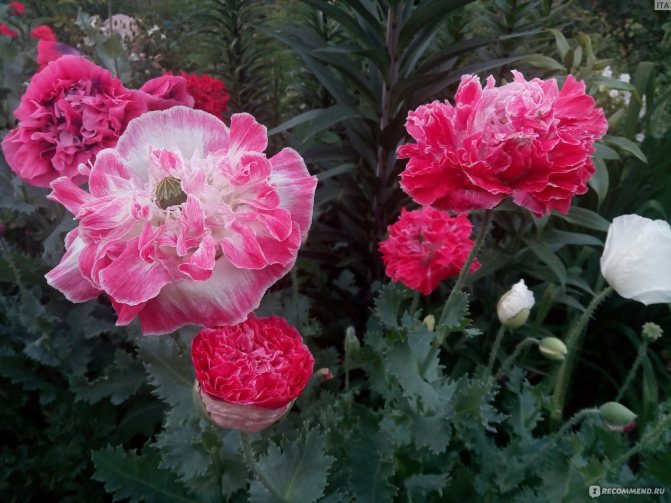

Desktop wallpaper
We suspect that after reading the article, you wanted to place a beautiful image of a beautiful flower on your computer desktop. Below you can find high quality pictures.To do this, you need to click on the thumbnail.
Reproduction methods
The peony poppy propagates by seed. It is enough to grow papaver on the site once and you can forget about the need for an annual planting. To collect seed material, 1-2 boxes are left on the bush, the rest are cut off before the seeds ripen. To exclude self-seeding, the seed box is tied with a thin cotton cloth. In this case, even if the capsule is opened, the seeds will not spill onto the ground.
One amazing feature has stuck behind the peony poppy: during self-sowing, the flowers retain their doubleness, but the shade of the petals is most often pink and light pink. To grow poppies of a specific color, you should purchase seeds of the appropriate variety from a specialized store.
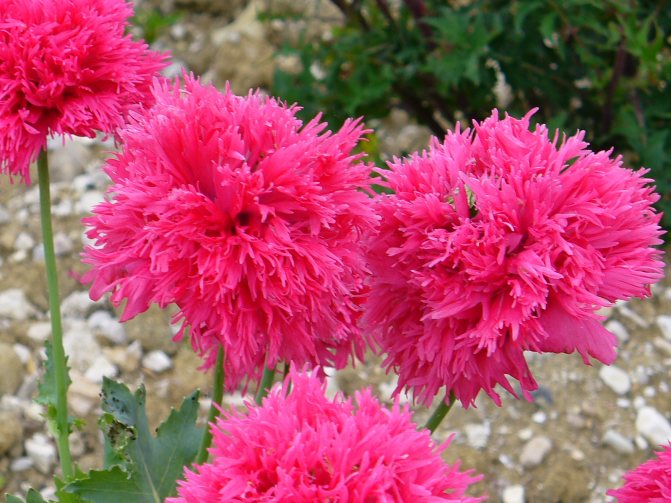

Growing from seeds
The peony poppy is planted in spring or autumn. These two methods are similar, but still have some differences:
Spring planting
As soon as the snow melts, the soil warms up to 3-5 degrees, they begin to prepare the future site for sowing seeds. The soil is loosened, stones and plant roots are removed, fertilizers are applied. Due to the fact that the seeds are small enough, they are mixed with sand, then scattered over the surface of the earth. There is no point in trying to distribute the seeds at an equal distance from each other, this is a useless exercise. After sowing, the place is sprayed with water and covered with a film, which will not only protect the seeds and seedlings from possible spring frosts, but also create a greenhouse effect. Seedlings will appear in a week, and the first flowers after 1.5 months.
Autumn planting
It is more correct to call such a sowing planting before winter. Seeds are applied to the already sufficiently cooled soil, literally on the first snow. Poppy seeds are spread over the prepared area and sprinkled with dry foliage. Until spring, you can forget about seeds, they will be subjected to natural stratification.
If the seeds are sown on the soil that has not yet cooled down, they will germinate and die with the onset of cold weather. Compared to spring planting, seeds planted in late autumn will germinate earlier, therefore, flowering will begin earlier. Young shoots should be covered when spring night frosts return.
With any method of planting seeds, the grown shoots are thinned out during the formation of 3-5 leaves, leaving a distance of 10-20 cm between the plants.
The peony poppy is an amazing, luxuriantly flowering plant. Its unpretentious disposition, easy reproduction, rapid spreading, have long made this plant a favorite flower for many gardeners. It will easily fit into any flower arrangement, will decorate various garden landscapes. A wide range of color palette makes the terry poppy an irreplaceable flower in floristry, allows you to make the most extraordinary compositions.
All the virtues of this culture
Although the flowers of the decorative poppy "live" only a couple of days, sowing the whole bag, you can get more than twenty bushes. Each one gives several flowers ... In general, such a flower bed will turn red for about a month.
Everyone knows that poppies are red. But they can also be white, pink and purple.
The blooming process of this flower is simply mesmerizing, and everything happens very quickly:


One bad thing: it is difficult to cut it to put in the house. First, poppies don't last long. Secondly, the petals of this culture are so delicate that you barely touch them, and creases immediately appear on them. Therefore, I immediately mulch the flower bed, because it is very difficult to get rid of weeds and at the same time not injure the poppy flowers.
But the decorative poppy:
- not picky about the soil;
- not afraid of both a sharp cold snap and drought;
- can perfectly decorate an open flower bed without fear of light.
This unpretentious plant is afraid of only one thing - a swampy area. Therefore, it is better to choose a flowerbed for him with loose soil. And if at the same time it is also nutritious, the flowers will bloom - all the neighbors for a feast for the eyes.
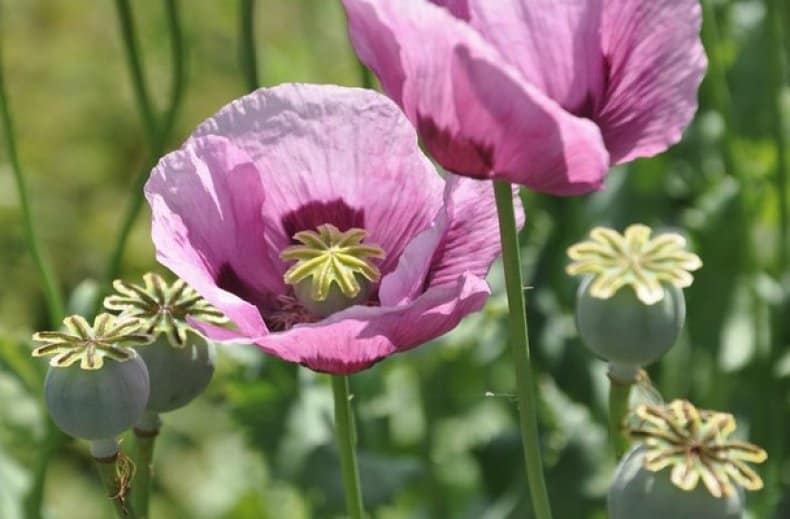

Is it legal to grow such flowers
- Decorative poppy is not food (the so-called hypnotic poppy), it has no narcotic properties, which means that it can be planted. True, not all species: we are also advised to refuse from the oriental, bracts, bristle-bearing poppies.
- On your site for beauty, you can plant up to 10 bushes. If there is more, the "organs" may get worried.
In any case, I would advise this: if your area is not the most calm environment (drug addicts are hunted - this is easy to understand from frequent petty thefts), and you really like the poppy, choose not red, but other decorative shades of the flower.
For example, you can sow purple or pink poppies (there are some among the East Pikoti). After all, you cannot explain to various scoundrels that the “wrong” poppy is growing on the flowerbed - seeing simple red petals, they will still fit in and only the flowers will trample in vain.
Important: there is also the Peony Poppy (Papaver). It does not look like food, but it is also considered narcotic, and some bad people hunt for it. Therefore, you can plant such beauty only if your fence is high and without holes.
Where and how they grow
Poppies grow in temperate, subtropical zones, in Russia on Lake Baikal. In arid regions, samosei poppies can often be observed occupying large areas. The most suitable climate for flowers in the Caucasus and Central Asia.
Most of the species are used for garden design, you can plant in the country, in residential areas, but there are those that are prohibited. These include oriental, bristle-bearing, sleeping pills. Poppy crops with a large capsule are immediately destroyed. Safe plants include self-seeding, modified, peacock, holosteel. The planting and cultivation of these poppy varieties is not prohibited.
The bare-stemmed poppy begins to bloom in the fall and ends in late fall. Poppies look especially beautiful when planted among other flowers. Poppy flower is unassuming, but very beautiful and varied.
Description and features of the plant
Poppy is a well-known herbal and, unfortunately, most of its fame is due to its intoxicating, narcotic properties. Although, in addition to this, it has both medicinal and aesthetic properties. It belongs to the Poppy family, which has more than a hundred species. Basically, these are unpretentious survivalists who prefer to live in arid deserts, steppes or in stones on the slopes of mountains.
The homeland of the flower is Australia, Asia, Southern and Northern Europe. But, since it is unpretentious, and is able to survive in a variety of climates, it is industrially grown for the preparation of sleeping pills in Afghanistan, India, China, Asia Minor and Central.
Gardeners prefer to grow ornamental poppy varieties for their simplicity and vibrant, colorful bloom.
Poppy features
Poppy is a herbaceous rhizome plant that can be a perennial, biennial, or annual. The taproot goes deep into the soil, while suction roots are placed along the periphery, which can be easily torn off during transplantation. The surface of powerful straight shoots can be pubescent or bare. Cirro-dissected or whole leaf plates can be opposite or alternately located, on their surface, as a rule, there is a hairy-bristly pubescence. Apical regular flowers have a large number of stamens, they are located on powerful and relatively long peduncles. As a rule, the flowers are single, but there are types in which they are part of paniculate inflorescences. Solid large petals can be orange, pink, white, red, yellow or salmon. The fruit is a clavate-shaped box with seeds inside; it is "clogged" with a flat or convex disc. When the box is ripe, it bursts, and its seeds scatter in different directions at a decent distance. The seeds remain viable for 3-4 years.
Legends and origin story
There are many beautiful legends telling about the origin of the passionate flower with delicate velvet petals, which is capable of plunging into sleep.
One of them says that when God created the earth, water, flora and fauna, everything turned out very beautifully. But under the cover of night, these beauties were hidden. Night tried to open them for its hour with the help of the stars, but this attempt was unsuccessful. And then God decided to help the Night and created the Dream and its dreams.
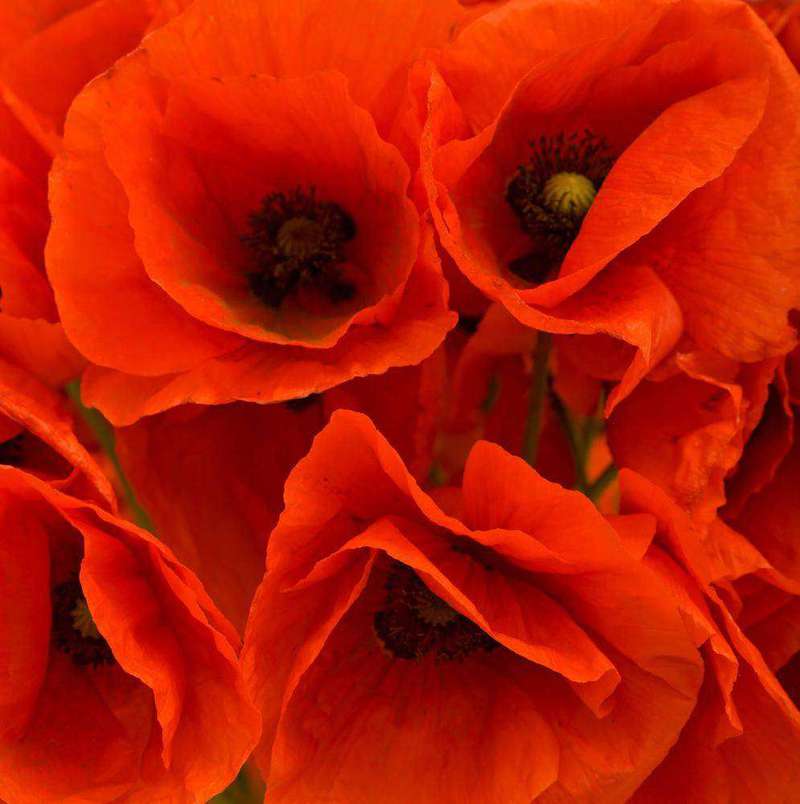

Over time, because of their cruelty, people began to dream not only good, but also terrible dreams, nightmares. Then Dream, with despair, thrust his magic wand into the ground, immersing him into sleep. The rod came to life and turned into a poppy, without losing its ability to plunge into sleep and cause visions. Since then, poppies have been considered dream-evoking plants.
According to another legend, the poppy is a symbol of earthly fertility and matrimony due to its extreme fertility - in its box there are up to 30 thousand small seeds that give life to new plants.
Many gods are depicted as decorated with poppy flowers. The goddess of earthly fertility, Persephone, is painted wrapped in intertwined poppy flowers. The Greek god of dreams and dreams Hypnos (among the Romans - Morpheus) is depicted holding poppy heads in his hands or crowned with a wreath of these flowers. On the head of the God of Death Thanatos - a young man with black wings, in black robes - also rests a wreath of poppy flowers. And this is not a complete list.
Obviously, this seemingly simple flower can make an impression. He entered the history and religion of different countries and many peoples due to his ability to induce sleep.
Poppy care
Poppies care. They do not require special treatment, since they are unpretentious:
- Have you found the time and energy to feed the flowers? This is good - they will react positively to it and will bloom more profusely. But, it is not necessary to feed them.
- Frequent watering is also not required. Basically, it is only needed during prolonged drought. It is also not necessary to water too much - it is enough to make sure that the soil does not dry out too much and retains a little moisture.
- It is important not to forget to weed the area with flowers from weeds, especially until the shoots grow into adult strong guys.
- To spend less time on weeding and watering, you can mulch the area with hay.
Where can one buy
As for the seeds, they can be purchased at any store, although the selection of varieties is not so large.
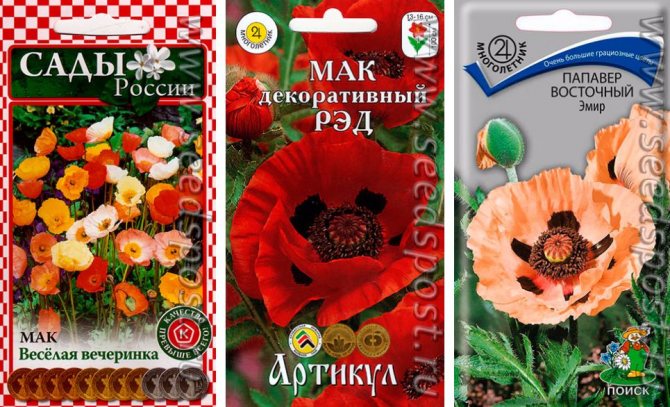

Varietal perennial oriental poppies are sold mainly by rhizomes. Most often these are Dutch-made plants. The table below shows where you can buy oriental poppy.
| Score | The cost of planting material, rub. | Is there a cash on delivery | Is there delivery in Russia |
| 500 | not | Yes | |
| 249 | Yes | Yes | |
| - the largest selection | 180 to 290 | not | Yes |
Harm and contraindications
It is not recommended to self-medicate with poppy-based infusions made on your own. This can be done after consulting a doctor or under his supervision. You can not use the seeds of the plant for diseases such as asthma, alcohol dependence, with gallstone pathologies, emphysema of the lungs. Poppy is also contraindicated for constipation, it can intensify them.
Children under 2 years old, the elderly are not recommended to eat confectionery with poppy seeds.
How to propagate poppy?
Plants are propagated by seed and dividing the bush. The second method is preferable because it allows you to preserve the mother plant. It is carried out after the onset of a dormant period. The seedling propagation method is not used, since the plants germinate and grow well when sowing seeds directly into the soil. The seeds are harvested after the leaves have dried, the poppy box dries up and holes open on it.
These bright plants bring joy and warmth, they look great on flower beds and lawns.Having planted poppy flowers along with other flowers, you can admire the resulting spectacular compositions for a long time. Alpine slides can be decorated with low varieties, and cut poppy flowers will make any bouquet bright and attractive.
What colors are poppies combined with?
Nowadays, poppy, as a spring flower, has become fashionable to add to different bouquets. It goes well with field plants such as forget-me-nots or daisies. In the garden, these bright flowers will look great in rock gardens and Moorish lawns. The combination with blue and white perennials sets off their bright color. You can use irises, peonies, daylilies, bells and other crops.
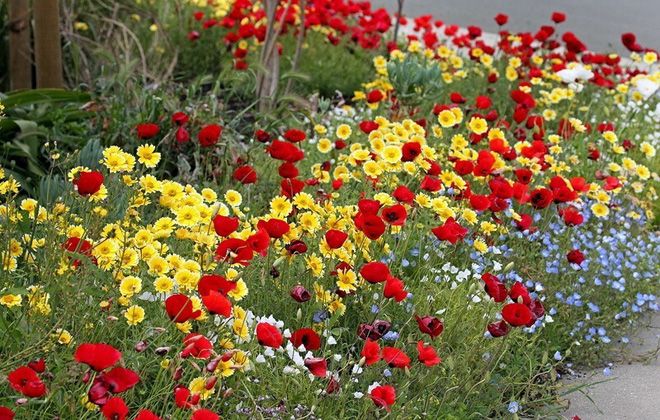

Reproduction
Poppies are propagated by seeds and cuttings. It is relatively easy to grow by seeds, but you will have to tinker with cuttings. You can make a cutting from the root or side shoots, which usually grow in early spring or towards the end of summer. But it will take a long time to germinate the stalk to a full state. Therefore, it is better to cut flowers towards the end of summer with the expectation that by the beginning of spring the seedlings will be ready for transplantation.
In the case of oriental poppy, grafting is rarely used, since it does not tolerate transplanting well. But, if such a need arises, it is best to carry it out in early spring and plant the cutting immediately on the site.
Usually grafting is applied to perennial varieties. Annuals themselves reproduce well enough with a high germination rate.
Poppy flower description
The Poppy family includes about 700 different species. The homeland is considered the territory of eastern Asia and western North America. It is worth understanding what a poppy flower looks like, and what characteristics distinguish it.
- The height of the stems is from 45 to 150 cm. They are straight and strong.
- The leaves are split into several parts or whole, often covered with small terry hairs.
- The buds are large, the petals are whole.
- Taproot, penetrating deep into the ground.
- The fruit is a club-shaped capsule with seeds.
Poppy flower structure
Representatives of the family are characterized by the presence of bisexual flowers, which are often located singly. The buds of the plant are large, bloom on long peduncles. In order to understand why the seeds are collected in a box, it is worth figuring out which poppy flower is from the inside: it is endowed with a double perianth, the first falls off early, and the second consists of four petals. The poppy flower has many stamens with thin or extended filaments at the top, which are gathered around the stigma. After the bud has flowered, a seed box is formed.
What colors are poppies?
Thanks to the work of breeders, these plants can be found in unexpected shades. Poppy flower can be of the following colors:
- scarlet
; - flower poppy blue
; - purple
; - snow-white
; - yellow
; - red-white
; - pink
; - red-orange
; - the black
; - red with white border
.
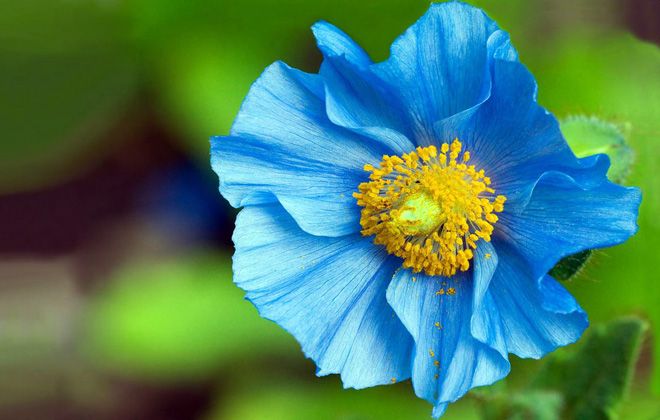

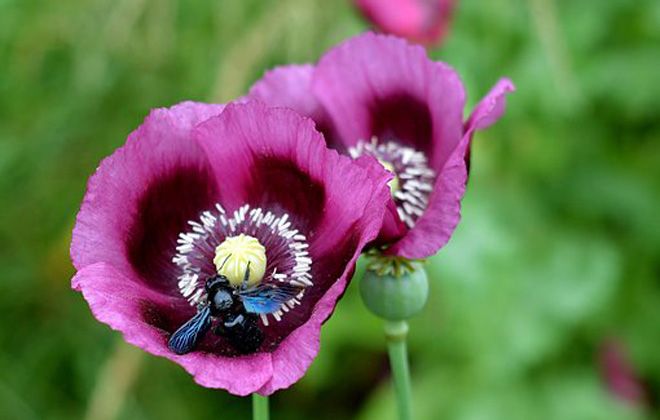

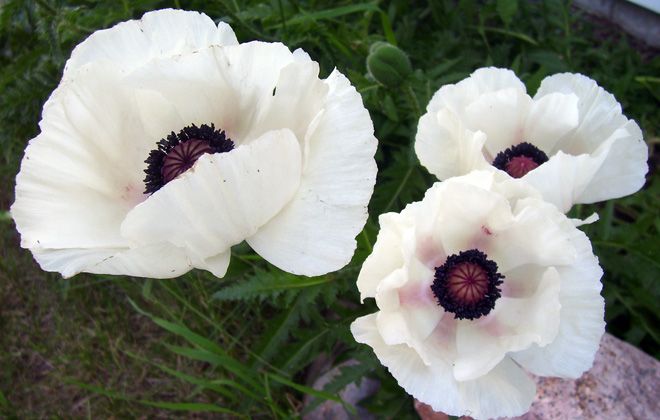

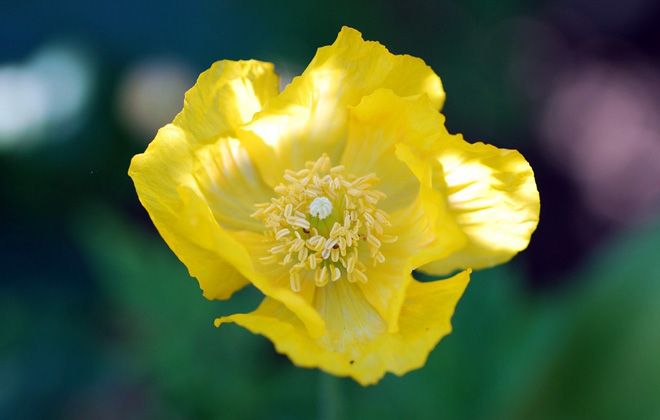

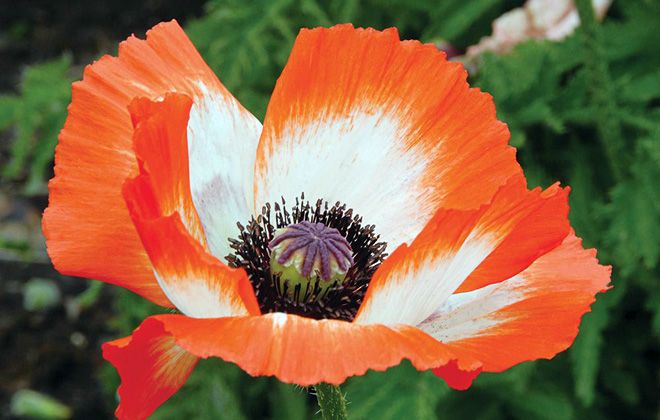

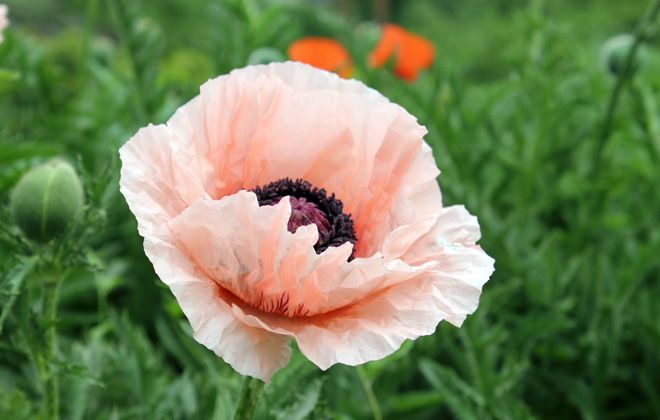



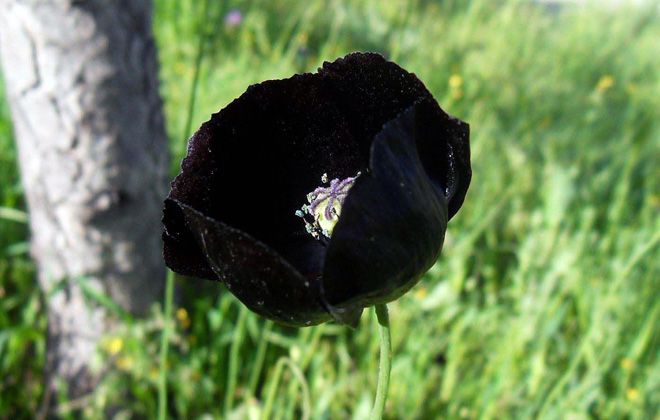

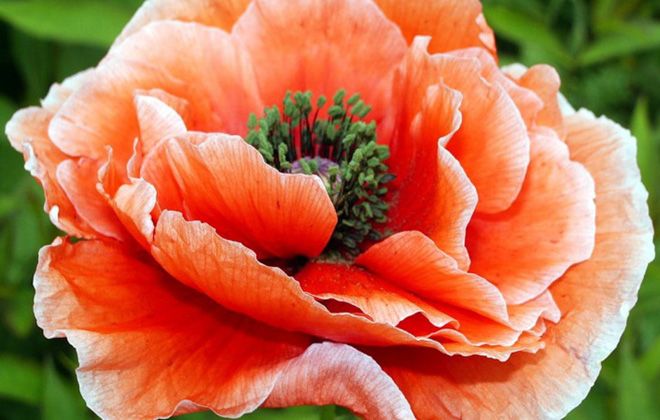

Botanical description
The genus Poppy includes about 70 species of various one-, two- and perennial plants with one or more strong stems. In some species, the stem may be missing. A distinctive feature of all Poppies is the release of an oily liquid by the stem and the fruit capsule when they are cut.
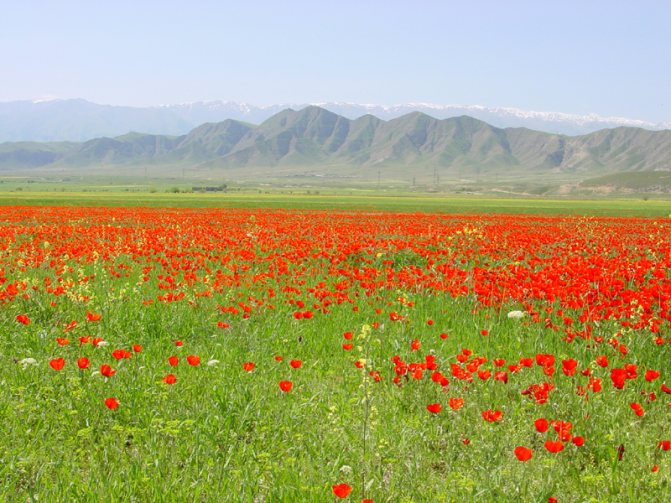

Poppy field
Why is decorative poppy valuable?
Poppy seeds contain a large amount of fat, sugar, proteins, vitamins PP, E, useful microelements, including: cobalt, zinc, phosphorus, iron, sulfur. Poppy seed oil is widely used in cosmetology. The seeds of the plant are actively used in cough therapy, as they have an expectorant effect. A seed decoction is also prepared, which helps to transfer discomfort in the ears, relieves toothache. The funds also actively contribute to the therapy of insomnia, pulmonary inflammation, and hepatic pathologies.
How and when does poppy bloom?
As a rule, poppy flowers bloom from mid-May to mid-June, one bush can form flowers for 1-2 months. The flower lives for a maximum of 2 days, but withered flowers are very quickly replaced by new ones. They bloom during the day and fly around at night.
If the plants grew from seeds, then only a few buds are formed in 2-3 years. After that, abundant flowering will begin. If the poppy is planted in a shaded area, the setting of flower buds will be greatly slowed down. Also, plants do not form buds in the absence of the necessary care. If you do active loosening and damage the root system, flowering will not start either.
When the bush is transplanted to another site, the buds are temporarily not formed - it takes some time for the plant to take root and adapt.
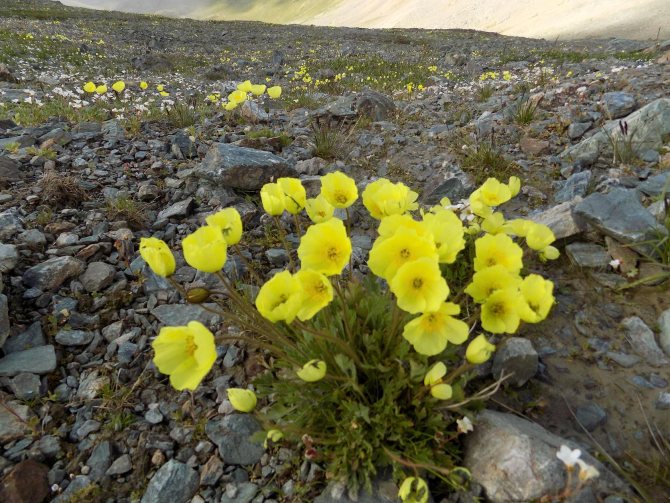

Types and varieties
By the forces of nature and breeders, many species and hybrids of poppy have been found and bred. Some species are used exclusively for decorative purposes, while others are widely used in pharmaceuticals.
Opium
The variety that is most widely used for its analgesic and hypnotic properties. Who has not heard about the opiates contained in this form, which makes it, on the one hand, terrible and very dangerous, but on the other hand, quite a few people were saved from painful shock thanks to drugs based on it.
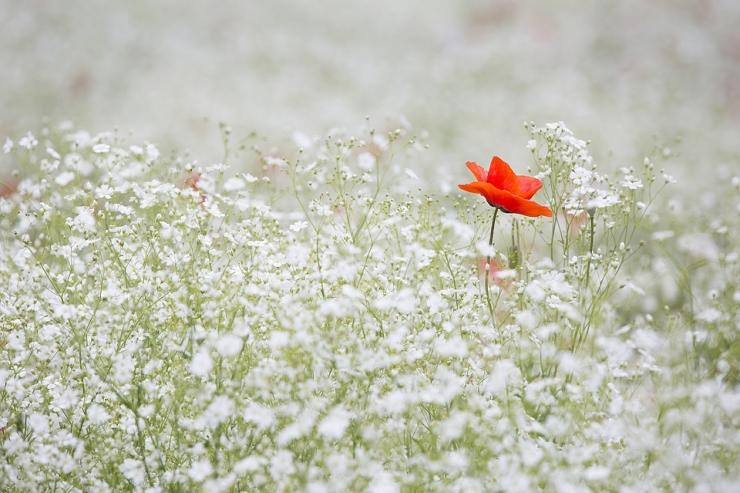

Samoseyka
Originally from the Mediterranean, Asia Minor, central Russia, Western and Central Europe. The height of the shoots varies from 30 to 60 cm. The diameter of the inflorescences reaches 7 cm, and the inflorescences themselves are white, pink, salmon.
The variety has been cultivated since 1569.
Holosteel
Holosteel or saffron poppy is a perennial, but in our country it is grown mainly as an annual plant. Central Asia, Mongolia, Altai and Eastern Siberia are considered the birthplace of saffron.
The stems are undersized and reach a height of only 30 cm. At the root, the stem is covered with bare or hairy leaves of light gray and pale green flowers. But the buds are quite large and open up to 50 cm in diameter. Colors: white, yellow, orange
| Attention! The cultivar is poisonous |
Eastern perennial
Perennial oriental poppy is one of the largest representatives of the family. The species is distinguished by a stem up to 1 m in height and huge flowers about 20 cm in diameter.
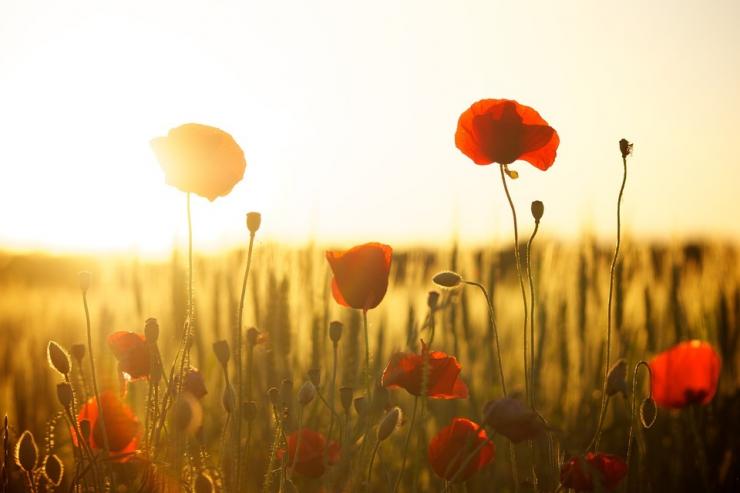

Nutritional value of confectionery poppy
One tablespoon of poppy seeds (about nine grams) contains approximately
- 45.9 calories
- 2.5 grams of carbohydrates
- 1.6 grams of protein
- 3.6 grams of fat
- 1.7 grams of fiber
- 0.6 milligrams manganese (29% DV)
- 126 milligrams calcium (13% DV)
- 30.4 milligrams magnesium (8% DV)
- 76.1 milligrams phosphorus (8% DV)
- 0.1 milligram copper (7% DV)
- 0.1 milligram thiamine (5% DV)
- 0.9 milligrams iron (5% DV)
- 0.7 milligrams zinc (5% DV)
- In addition, poppy seeds also contain vitamin E, folate, choline, potassium, and selenium.
RDA - Recommended daily intake
Research shows that consuming even large amounts of poppy seeds, between 35-250 grams at a time (the equivalent of three to eight tablespoons), is safe for most adults. However, large amounts of maca can cause digestive problems due to intestinal blockages.


The content of the article
Health Benefits of Poppy Seeds
Poppy seeds have long been used to help treat a variety of ailments, including:
- Insomnia
- Suffocation
- Constipation
- Diarrhea
- Cough
- Vesico-intestinal fistula
- Relieving pain
Poppy seeds are a decent source of nutrients, including manganese, calcium, phosphorus, zinc, and iron. If we ate more poppy seeds than most of us (rarely more than one or two teaspoons or so at a time), then we would indeed be consuming a good amount of essential nutrients.
The legend of the poppy flower
There are different legends in the world, so one of them tells how the wild (decorative) poppy flower appeared. When the Lord finished creating the earth, everyone except the night was happy. No one loved her because all the beauty of the world was hidden in her darkness. To fix this, the Lord created a dream, which, having made friends with the night, became a welcome guest for all living beings on the planet.
Over time, passions began to awaken in people, and they began to do bad deeds. The dream could not stop this and in anger stuck his magic wand into the ground, into which the night breathed life. After the roots and greenery appeared, the rod, while retaining the power of sleep, turned into a beautiful plant, which was called the "poppy flower". Then they began to use it to prepare a sleeping potion.
Procurement and storage
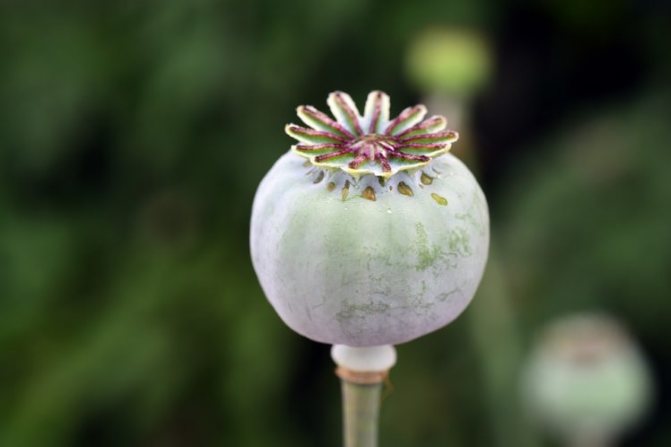

Poppy petals are picked by hand during flowering, dried under ventilated canopies, spreading in a thin layer of 1-2 cm on paper or fabric. packed in bags, stored in dry, dark places. The poppy flower is used to treat coughs.
The sleeping pill is grown on production plantations that are strictly guarded. Harvested with combines after the capsule is fully ripe. Dried under awnings, used for medicinal preparations containing opium.
Poppy after flowering
At the end of flowering, you can collect baskets of seeds, regardless of whether you use them for planting or not. If the seeds are not collected, some of them will self-seed, and in the new season the flowers will grow on their own. Perennial plants are cut flush with the ground. Harvested flowers are not recommended for compost and are best burned.
The soil for perennial plants can be covered with spruce branches, hay and dry leaves, in case the frost starts before a lot of snow falls, and will not cover the site until next spring.
Poppy growing conditions
The plant loves well-lit areas and light fertile soils. Poppy does not tolerate close occurrence of groundwater and acidic soil. Otherwise, the plant grows well on all types of soil. Before planting the poppy, the site is dug up, removing the roots of the weeds.
On heavy clay soils, it is recommended to add sand, at the rate of 7 - 8 kg per 1 sq. meter. All types of soils are filled with humus, at a dose of 8 - 10 kg per 1 sq. meter. You should not get carried away with fresh organic matter, this can lead to the occurrence of fungal diseases.
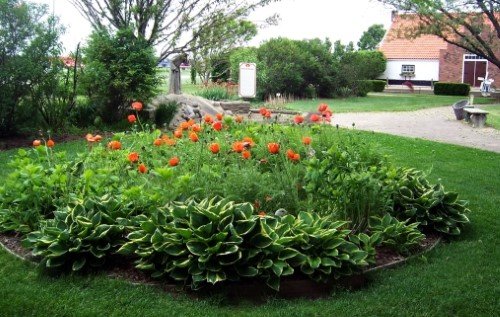

Flower in the garden
How to harvest seeds correctly
To collect seeds, you need to wait until the bushes not only fade, but wither and turn yellow. And the seed boxes are completely dry. It is necessary to carefully cut the boxes and pour the contents into a tissue or paper bag. The seeds should be almost black, which means that everything is ripe.
It is recommended to store them in a dark, dry and cool place.
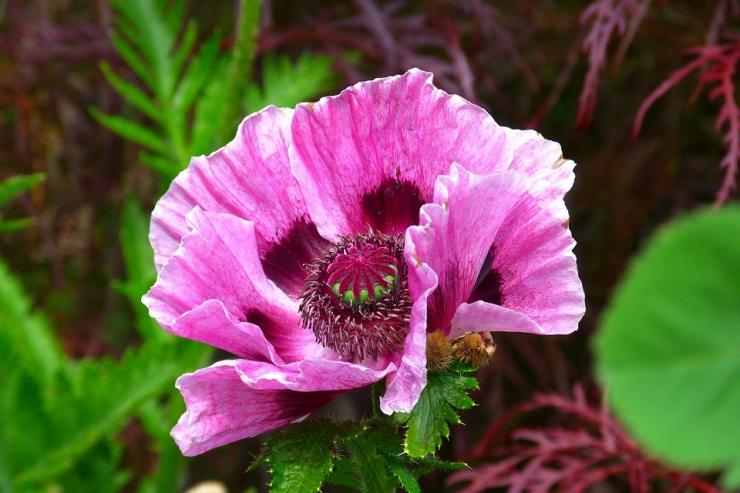

Useful and harmful properties
The medicinal properties of the unique poppy plant have been known since ancient times. Poppy seeds normalize the digestive system, relieve dysentery and diarrhea. Using them, you can get rid of insomnia and eliminate some diseases of the upper respiratory tract. Poppy is widely used in the treatment of oncological diseases.
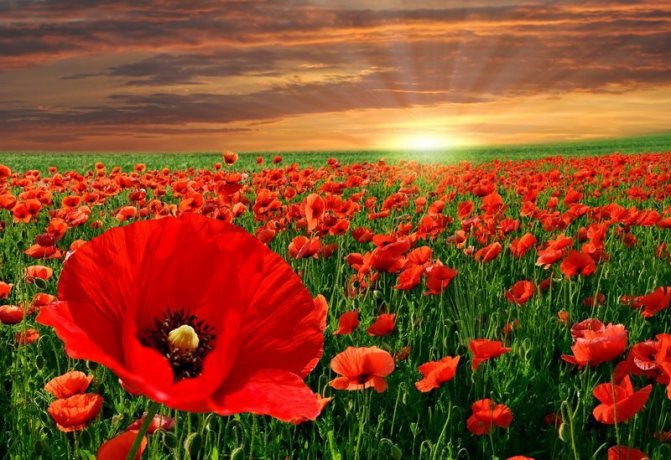

The harm of poppy is due to the unreasonable use of it by the person himself. This magic flower serves as the basis for the production of opiates, the excessive use of which leads to drug addiction, which destroys the human psyche and brings terrible torment to the addict.
Poppy seeds are widely used in cooking as additives in baked goods and a wide variety of sweets and cookies. At the same time, the beneficial properties of poppy seeds are fully preserved, provided that it is correctly collected and dried without the remainder of narcotic substances in it.
Leaves, roots and stems of the plant are used only in medicine... They are not eaten.
Benefit
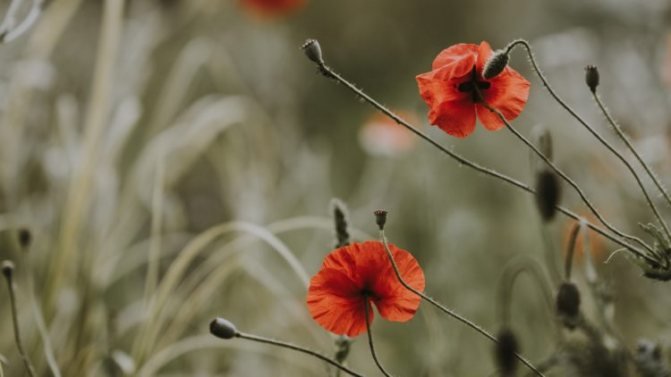

The benefits of poppy are in the content of vitamins, trace elements, minerals that have a beneficial effect on the human body. Calcium minerals are positively and easily absorbed. The seeds of this plant are used in the preparation of infusions, which are taken for nervous diseases, for restful sleep, to relieve fatigue, from convulsive cough.
Poppy is also an anthelmintic, useful for diarrhea. Poppy seed products are used in cosmetology, and poppy seed milk is a food for vegetarians. In addition, poppy seeds are high in calories.

